To view this content, you must be a member of the Rose City Review Patreon
Already a qualifying Patreon member? Refresh to access this content.
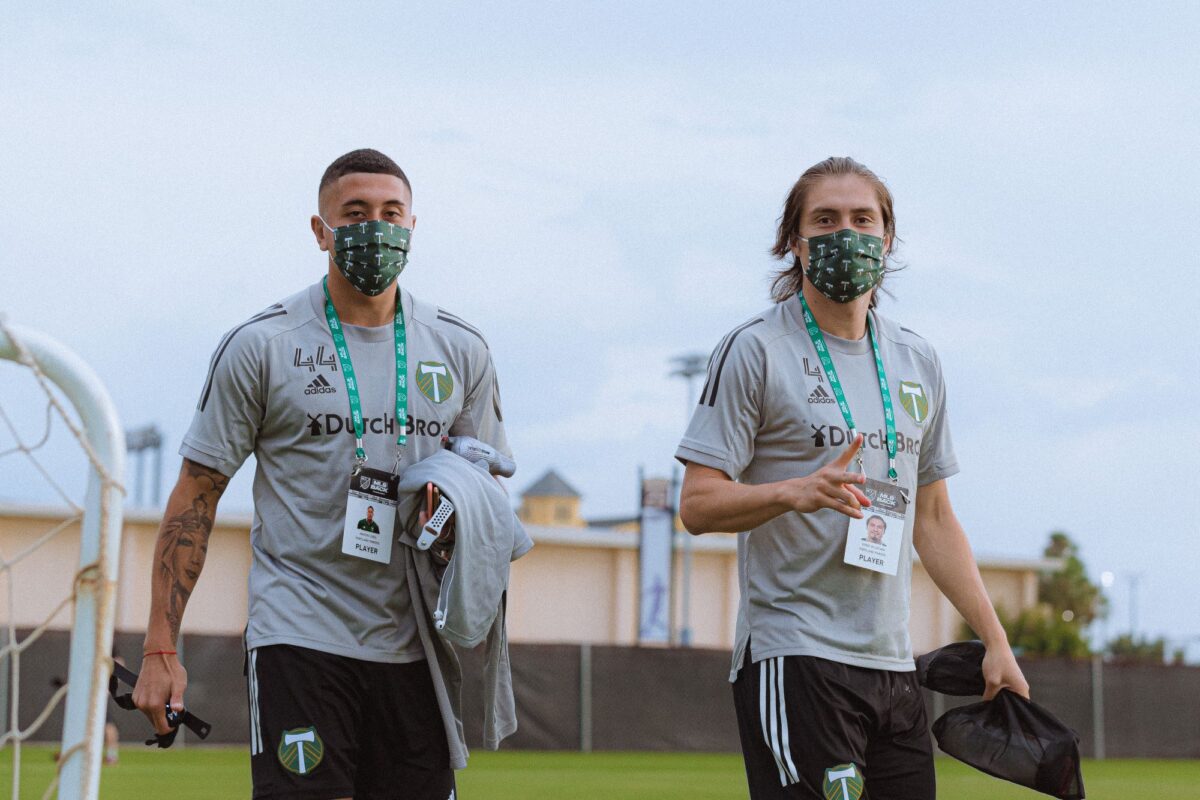
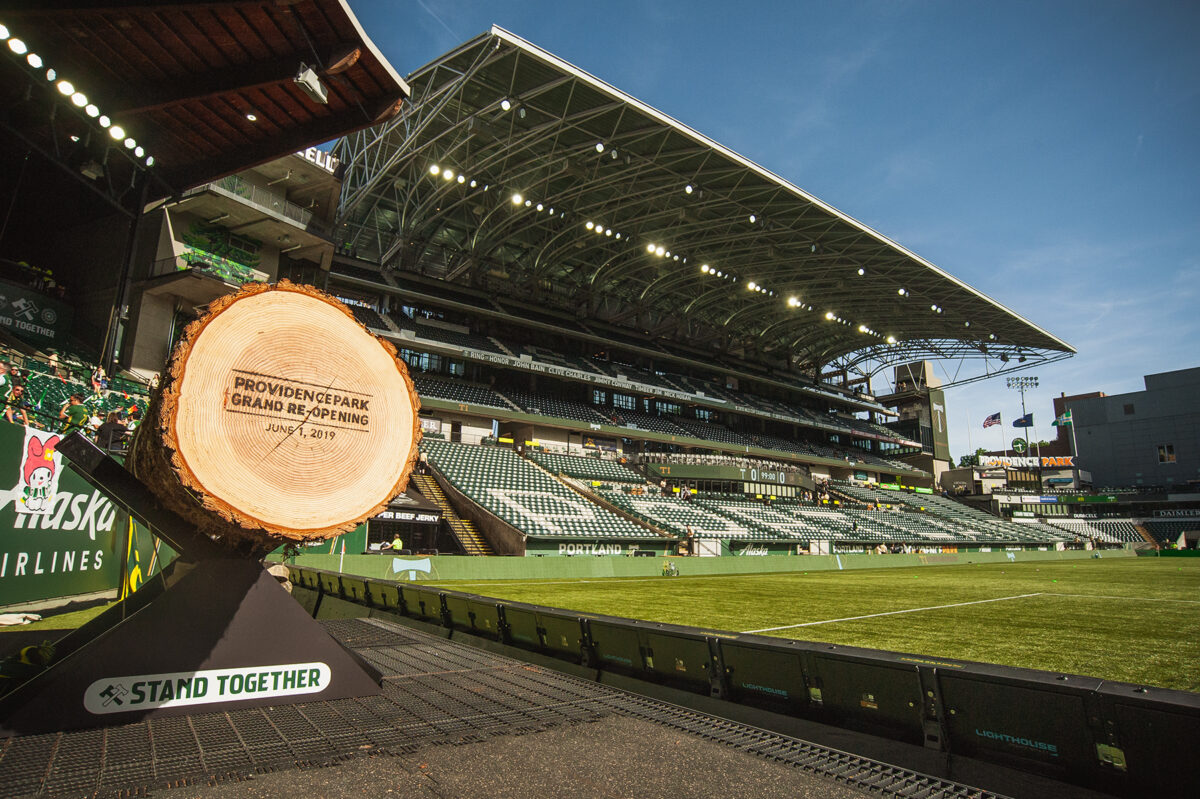
June 9, 2011 was a perfect day for soccer in the Midwest.
Almost a decade has passed since Sporting Kansas City christened then-Livestrong Sporting Park, but Rick Dressel, the team’s Director of Team Administration, recalls every detail perfectly.
He remembers watching The Cauldron come to life for the first time—the electric atmosphere as the temperature dropped and kickoff loomed. That night, a recorded 19,925 fans filled a stadium with an official capacity listed at 18,467. The final result—a 0–0 draw against the Chicago Fire—may not have been the most entertaining, but it’s a night that will always stick with him.
“That night compared to the night we won it all back in 2013, as far as the energy goes,” Dressel said. “It was a beautiful night, perfect soccer weather. The energy of the place, the players’ energy level, just everything was like a cup final. To do that for the first time—and we’ve experienced opening up stadiums before as a road team, and always have thought that was pretty cool—you can feel the electricity, and that night’s atmosphere is one I will never forget.”
In the 25-year history of Major League Soccer, just five teams—including Sporting—have started their seasons with at least eight consecutive road games. From lack of chemistry to inconsistent results, each team undoubtedly faced its struggles, but also developed a sense of camaraderie. To many in these organizations, the trips came to define much more than the current season; they defined a new era with a new stadium, oftentimes more exciting and fortuitous than the one it left behind.
Six games into their 2019 season, the Timbers were in trouble. Sitting on just one point nearly halfway through their twelve-game season-opening road trip, the team needed a spark.
Portland had opened the season with a 3–3 draw against the Colorado Rapids in what was one of the coldest regular-season games in league history. In that match, a late equalizer from Rapids rookie Andre Shinyashiki provided a preview of the rough weeks to come.
In their third game, the Timbers lost 3–0 to FC Cincinnati, one of the league’s worst teams at the time. In their fifth, Portland gifted the San Jose Earthquakes their first win of the season in another 3–0 defeat.
Shortly after their loss at Avaya Stadium, Portland held a team meeting.
“Once we had that reflection, some words were said, and some feelings were vested in that moment,” forward Jeremy Ebobisse said, “but we started to turn it around and played better together.”
“You know that the first five games of the year do not make or break your season,” goalkeeper Jeff Attinella said. “Obviously you want to get out to a good start, but I think the circumstances that we were in were beyond challenging when you’re thinking about coming off a Cup final.”
The team seemed to find a spark of momentum in Frisco, Texas the next game. A controversial handball called in the 95th minute denied the Timbers a late point against FC Dallas, but the result gave players a bit of hope. The next week, the Timbers picked up their first win of the season, beating the Columbus Crew 3–1 at Mapfre Stadium.
“When they scored early in that game in Columbus to go up 1–0, you could just feel the team loosen up, because they hadn’t scored first in any game that year,” Timbers TV play-by-play announcer, Jake Zivin, said. “Columbus had some good chances in the first 30 minutes, and you don’t want there to be that feeling of ‘here we go again.’ Then they score and you could sense the mood rise. From then on it was like, ‘Okay, they’re back. This is what we’re used to from them.’”
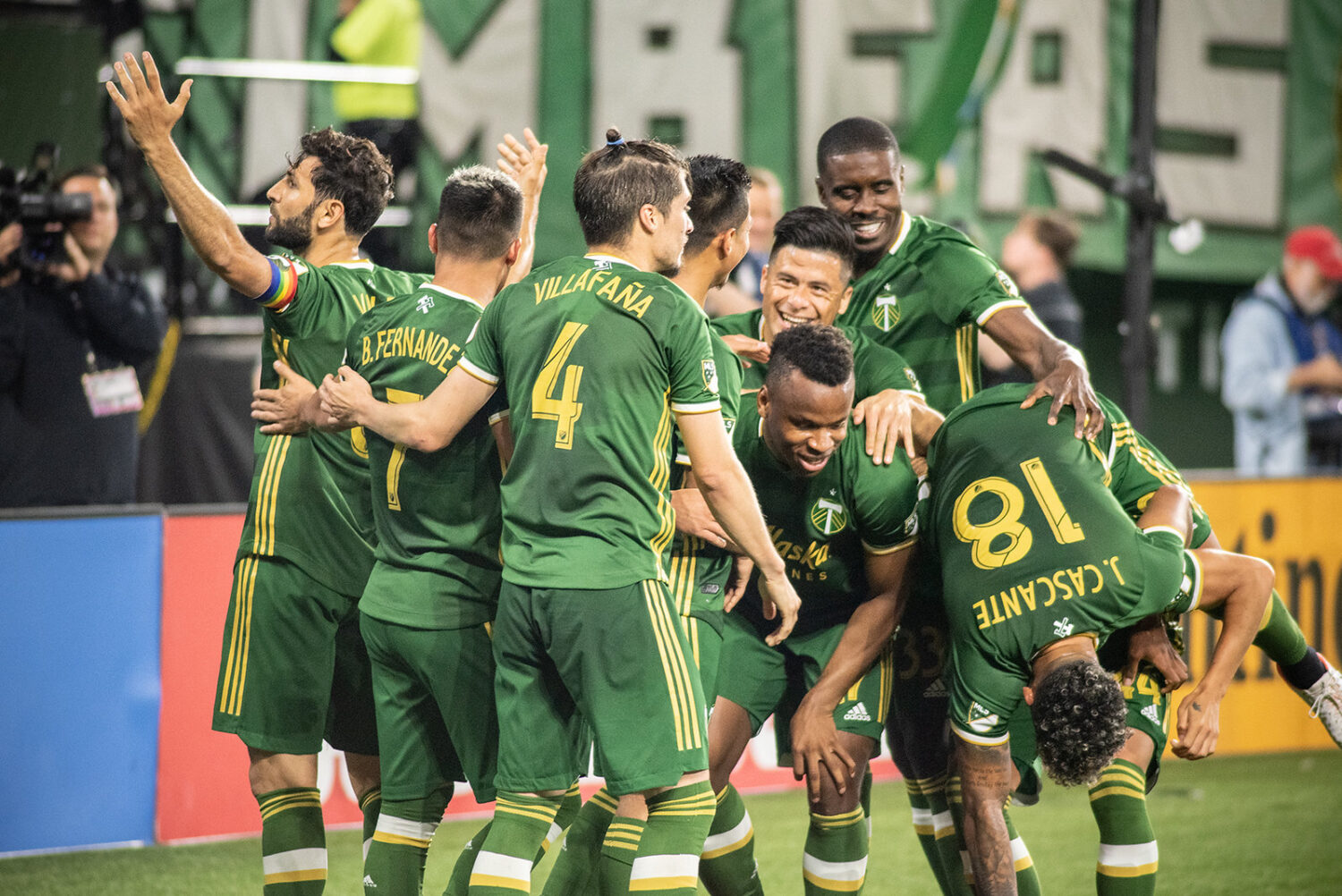
By the time the 12th and final game rolled around, the Timbers were sitting on 11 points. 90 minutes later, they would leave Chester, Pennsylvania with three more after defeating the Philadelphia Union 3–1. As summer—and a long homestand at newly renovated Providence Park—approached, the Timbers had just five road games remaining on their schedule.
“Given the adverse conditions, having the cross-country trip, that was a game we were willing to concede, but we came out flying and in good form,” Ebobisse said. “That was the end of our road stand as well, so we got over this massive hump, and that was a major boost for what was to come.”
If, in March of 2011, you had asked Callum Williams to point out Salt Lake City or San Jose on a map, you may have been met with a blank stare.
The 21-year-old broadcaster from Birmingham, England took a chance on American soccer when he traded his job with the BBC for a play-by-play broadcasting position with Sporting Kansas City. Just six days after landing in Kansas City for the first time, he was off to Los Angeles to cover the team’s first game of the season against Chivas USA.
Williams learned a lot about North America and its intricacies during that opening road trip. Vancouver, BC became one of his new favorite cities, and now he has family there. Williams estimated that he spent more time at Chicago’s Midway Airport than he did at his new home in Kansas City over the season’s first few months.
“I’ve never heard of Columbus, Ohio. I’ve certainly never heard of Denver, Colorado, and all these other places,” Williams said over Zoom. “For me, I relied a lot on adrenaline, and because I was so young and because I had such enthusiasm for the new challenge, it all went by in a flash, really.”
Necessary tasks like getting a Social Security number, viewing apartments, and obtaining a driver’s license took a back seat to jetting around the United States and calling games for a struggling Sporting side that couldn’t seem to find any positive momentum.
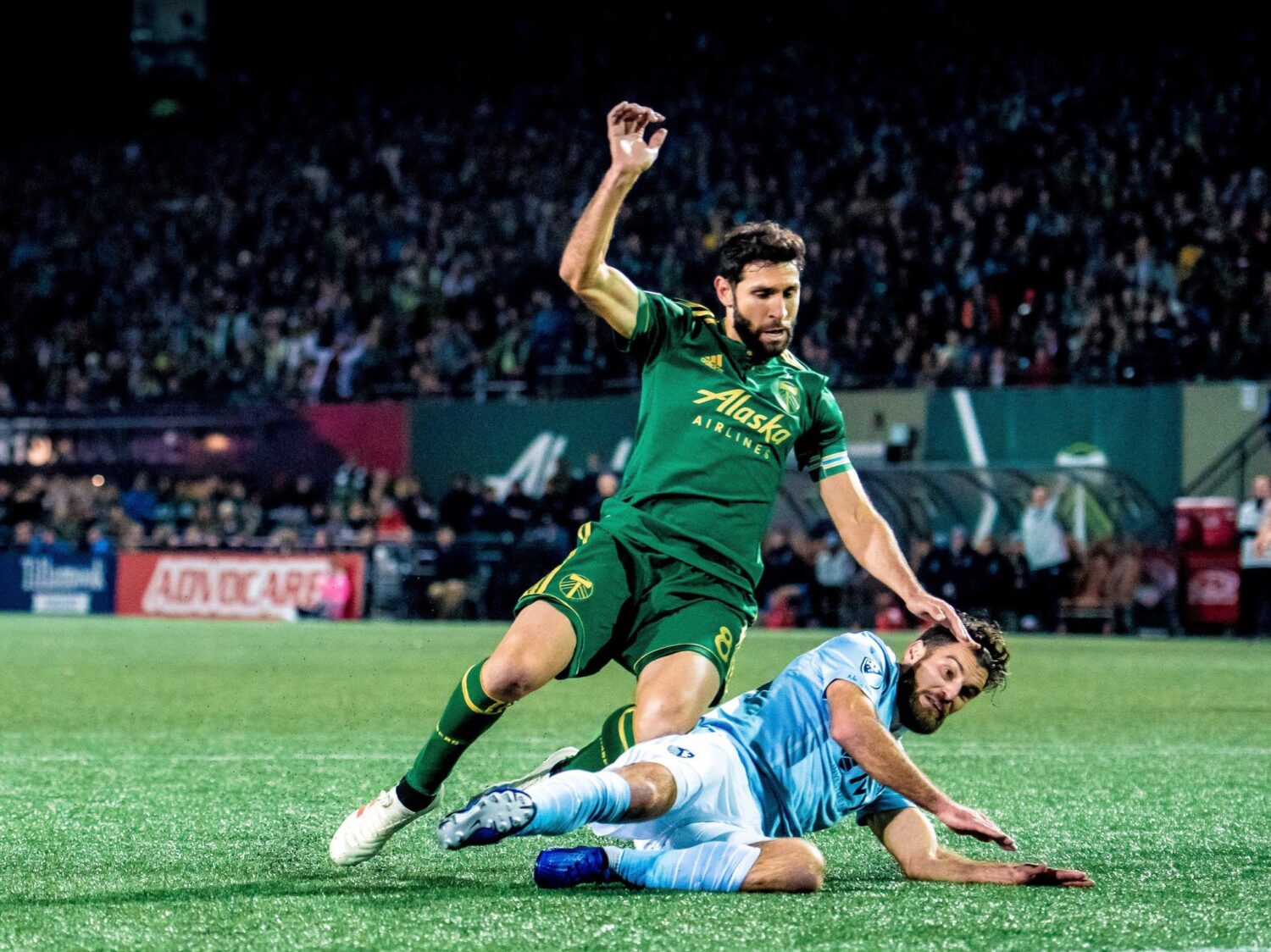
That season, Williams forged a solid working relationship with head coach Peter Vermes, who always took the time to talk to the young broadcaster and answer his questions.
Despite the criticism that Vermes received when his team sputtered out of the gate, Williams and Dressel both believe that he was a big reason as to why the team didn’t break early on.
“The way Peter coaches, he tends to have a really good group of guys because of the way he coaches and the way he expects everybody to put their chair in,” Dressel said. “We typically have really good players, so I can’t think of any challenging moments in that respect.”
Behind the leadership of Vermes, Sporting rallied in the second half of the season, making its way to the 2011 Western Conference Finals before eventually being eliminated by the Houston Dynamo.
Nick Hagglund arrived in Toronto to what appeared to be a team in transition. The tenth pick in the 2014 MLS SuperDraft draft would be joining a team that finished ninth in the East a season ago, but also one that just spent big money to land Jermain Defoe and Michael Bradley.
With just ten games remaining in Hagglund’s rookie season, the team fired head coach Ryan Nelsen and promoted its academy director, Greg Vanney, to the role. This all came with looming renovations to BMO Field, which would force Toronto to start the following two seasons with long road trips.
Vanney was keenly aware that spending long weeks away from home spelled potential disaster, but also figured that the trip could help the team build chemistry. Luckily for him, his second theory proved correct.
“For us, it felt like [the road trip] set a good foundation for the rest of the season, so that when we came into our form, we were defensively sound and we were able to play the soccer that we wanted to,” Hagglund said.
In Hagglund’s mind, there was no bigger reason for the team’s eventual upswing than Bradley’s leadership. Yes, the talent was there, with players like Sebastian Giovinco and Jozy Altidore, but many acknowledged that Bradley was the glue that held everything together. In many ways, he was TFC’s culture.
When asked to expand on Bradley’s influence, Hagglund brings up his first-ever MLS game against the Columbus Crew. Like any rookie would be, he was anxious, but Bradley soothed the 22-year-old’s nerves by telling him to relax, play simple, and find him. And that leadership wasn’t just displayed on the field.
“He cared about the whole organization,” Hagglund said. “It wasn’t just about the team. He cared about the organization from the top to the bottom, doing things the right way, and demanded those things to be done the right way. From how the field is to how families are taken care of, he truly embodied what the club was about.”
Luke Wileman, who often calls TFC’s games for Canada’s The Sports Network, spent a lot of time around the team during those seasons. He believes that Toronto’s 2017 treble-winning team would not have been possible without the culture and work ethic that Bradley set back in 2015.
“You need leaders in those situations, and I think one of the reasons TFC has been so successful is because of the change in culture, expectation, and leadership that Michael Bradley brought when he originally came in,” Wileman said. “It’s those kinds of leaders that you need to build that culture. Michael Bradley is invaluable in terms of setting the standard and holding players accountable. That was a key for TFC.”

According to those who spent time around the four teams, the importance of having a leader on these long road trips cannot be understated. Yet, while DC United had veterans, the abundance of younger players made the team’s 14-game opening road trip in 2018 all the more unique.
United played 12 of their first 14 games on the road, but their two home games came at the Naval Academy in Annapolis, Maryland, and 4,000-seat Maryland SoccerPlex, respectively. When the team began to play at Audi Field, many within the organization still joked that they still felt as if they were going to National Airport.
“You don’t think that in a few months, in the heat of summer, Wayne Rooney is coming, but you knew what was coming at the end of the summer in Audi Field, a new stadium. You’re just going to get energy from that,” DC United play-by-play voice, Dave Johnson, said.
The young core of players bought into that idea. They knew going into the season that the trip wouldn’t be easy, but they committed to growing together as a team, and by the end of the season it paid off.
By the end of the road trip, whether it was seven weeks or 14, every team expected to come home to either a brand-new or renovated stadium for a lengthy homestand. While these opening road trips seemed to drag on, there was always a light at the end of the tunnel.
Hours before Toronto FC’s first game at freshly renovated BMO Field, the organization held a grand reopening ceremony to celebrate a project years in the making. Vanney, Mayor John Tory, and then-Maple Leaf Sports and Entertainment president Tim Leiweke were among those in attendance to usher in a new era of soccer in Canada’s biggest city.
The sun shone down in Toronto, and the mood couldn’t have been better. With the team returning home on eleven points, there was plenty of optimism around the organization. With a new roof in place and expanded capacity, the team finally had a home that matched its ambitions.
“When the team signed Defoe and Bradley, [Leiweke’s] big thing was, ‘Why can’t we be great?’” Wileman said. “‘TFC has had all these things go wrong, but why can’t we be great? Two years later, they make the playoffs for the first time, they have Altidore, Bradley, and Giovinco in. Now they are opening up this stadium that looks so much better than it used to.”
“Seeing the stadium for the first time, it was like ‘Wow,’” Hagglund said. “This is a true football stadium. This is going to be packed. You’re going to live for the darkest nights where it is rainy, where it is cold, and the lights are on with the place packed and ready for big games.”
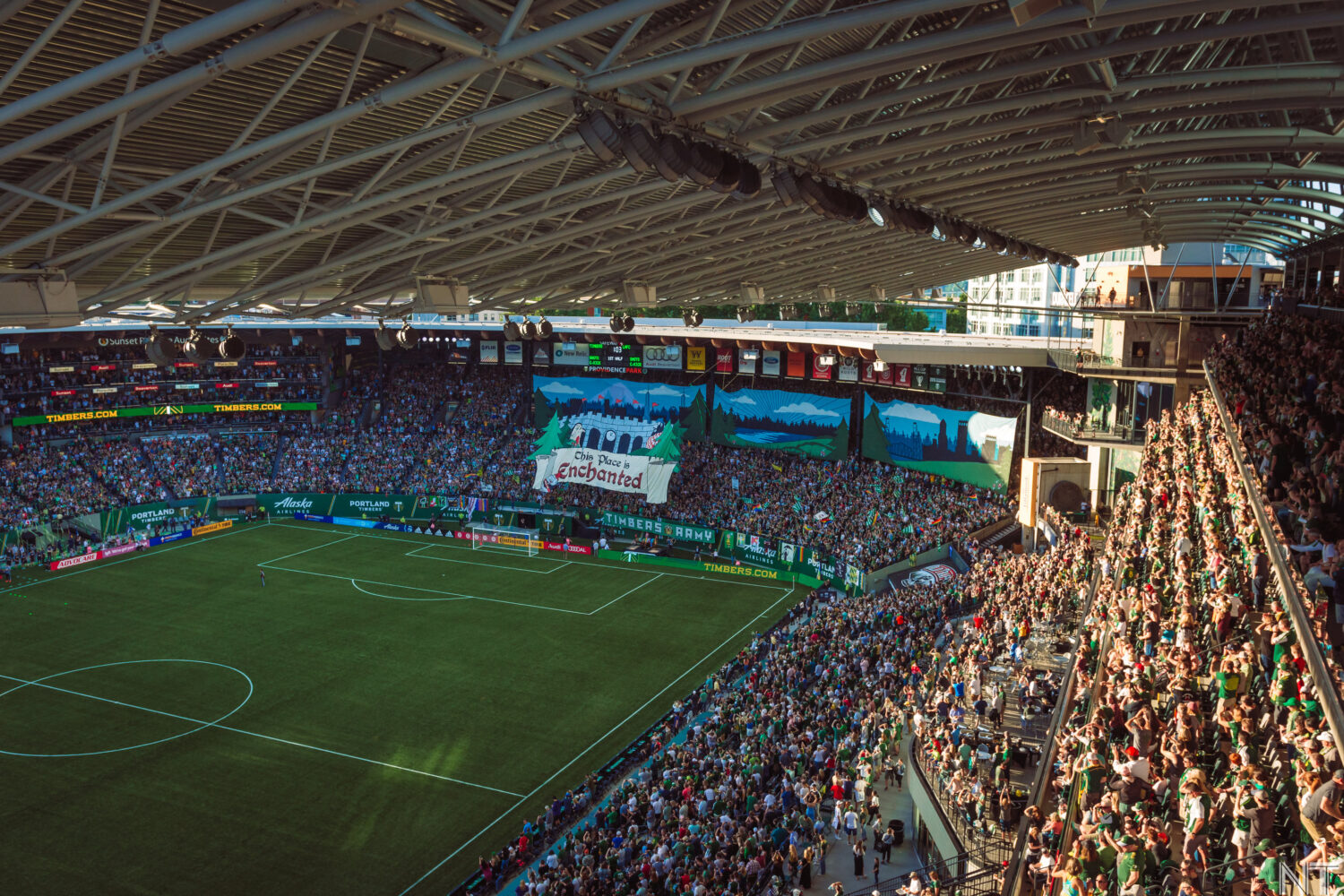
In DC, opening night at Audi Field felt just as surreal, but for a completely different reason. If you were to have told Johnson, who started calling the team’s games back in 1996, that he would be covering the club in a brand new venue in the heart of Washington, DC, he might have laughed. This was Washington, after all, where politics and bureaucracy often make it impossible to land a downtown stadium. Johnson brought up past examples in which local professional teams tried and ended up with stadiums in Landover, Maryland.
Little did he know that 24 years later, Wayne Rooney would be suiting up for United the same summer that sporting excitement in the city was reaching all-time highs. It was a far cry from past seasons of playing at a run-down RFK stadium, to say the least.
“There’s no lightning in a bottle story here,” Johnson said. “Soccer has been laid down for fifty years. In Washington, DC, go look at 1980, when Johann Cruyff played with the Diplomats. They averaged 20,000 fans a game. Look at what Portland did, or what Seattle did in the old NASL. All of this doesn’t just happen overnight. People grow up with the sport, and that’s why you reach your position now.”
When asked to look back and reflect on whether or not the road trips and the hassle were worth it, nearly everybody took a moment to collect their thoughts. At the end of the day, nothing compared to the feeling of coming home: the packed stadiums, the unique energy, the chance to be there for a unique moment in franchise history.
“This stadium changed absolutely everything in [Kansas City], and I think that leading up to the stadium, it’s a story that doesn’t often go told honestly,” Williams said. “A lot of people weren’t really fans at the time, or only started following it when the stadium was built. It was a period of adjustments, a stage of a lot of those players’ lives where they had to prove they could play at this level as well. It was a fascinating introduction to the world of Major League Soccer, and it was a stage of my life that I will never forget.”

Players have been tested, teams are beginning to filter into Orlando, and we are just over a week away from kickoff of the MLS is Back Tournament.
Nearly four months have elapsed since LAFC and the Philadelphia Union played to a 3-3 draw back in early March. And before Inter Miami and Orlando City take to the field, Rose City Review talked to Joe Lowery—who currently co-hosts the MLS Assist Podcast—about the Timbers’ potent attack, defensive question marks, and the many ways in which they could create chaos in Orlando.
(The conversation below has been edited for clarity and length)
Kyle Pinnell: It’s been about a week since the draw. What were your initial thoughts on Group F, and more specifically, the Portland Timbers?
Joe Lowery: It’s going to be really interesting in terms of the on-field stuff, right? It’s going to be interesting to see how teams take things and how coaches want to approach the group stage which is actually worth points long term. There are a lot of questions as far as that goes, but looking specifically at Group F, there are a lot of unknowns in that group, I think.
You have LAFC, and we kind of know what we are going to get from them, although it will be interesting with the addition of Andy Najar to see how that is going to change things if he gets minutes. With the Timbers, Houston, and the Galaxy, to be honest with you, those teams all have large question marks around them.
The Timbers, I don’t think they defended well. Their defensive block, which is really really important to how they want to play, wasn’t very solid. The Galaxy are still trying to figure out how to attack with Chicharito and Cristian Pavón, and then the Houston Dynamo are right in this revamp under Tab Ramos, and they’ve only had two games to sort that out—those games were without Alberth Elis. We don’t really know what the Dynamo look like, we know what the Timbers want to be, and we know what the Galaxy want to be, but they aren’t there yet either. There are a lot of unknowns, especially after LAFC, in that group.
Pinnell: Yeah. We know how the Timbers want to play, they want to press and play a beautiful style of soccer, but that has turned into counter-attacking, playing long balls over the top, and hoping for interesting results. Over the first few games of the season, what have you seen when you watched the Timbers?
Lowery: With the Timbers, it’s interesting to me because every coach says that they are going to play with the ball, every coach wants to have the ball for the most part. The Timbers, in a way, still have the pieces to do that. They have two of the highest skilled on-ball players in the league with [Diego] Valeri and Sebastián Blanco. You think about having those two guys as attacking midfielders in a possession scheme, that sounds pretty nice, I love that idea. You have Diego Chará who is nice on the ball as well and he can do things in possession as a number six.
They have options here in certain spots, but not all the way around, and I think that is the problem here. They have guys along the backline, specifically center backs, that I don’t think are great with the ball. I’ll have to watch them more, but they never stood out to me as being these offensive powerhouses, which makes it difficult to keep possession a lot of the time.
Whether it’s the center backs or it is the fullbacks or the team not having that cohesion in possession, so often I think they revert to what seems to be their DNA for one reason or another. That’s sit in a defensive pocket, press occasionally, and then win the ball and have Diego Valeri and Sebastian Blanco be the playmakers on the fast break. They can do more things than that. They can hold the ball and play through those guys in possession, but for some reason, they seem to continue to go back to that counter-attacking style, which is fine, it’s a totally viable approach, it just seems like they are lacking a little bit in terms of their tactical identity with the ball on the field.
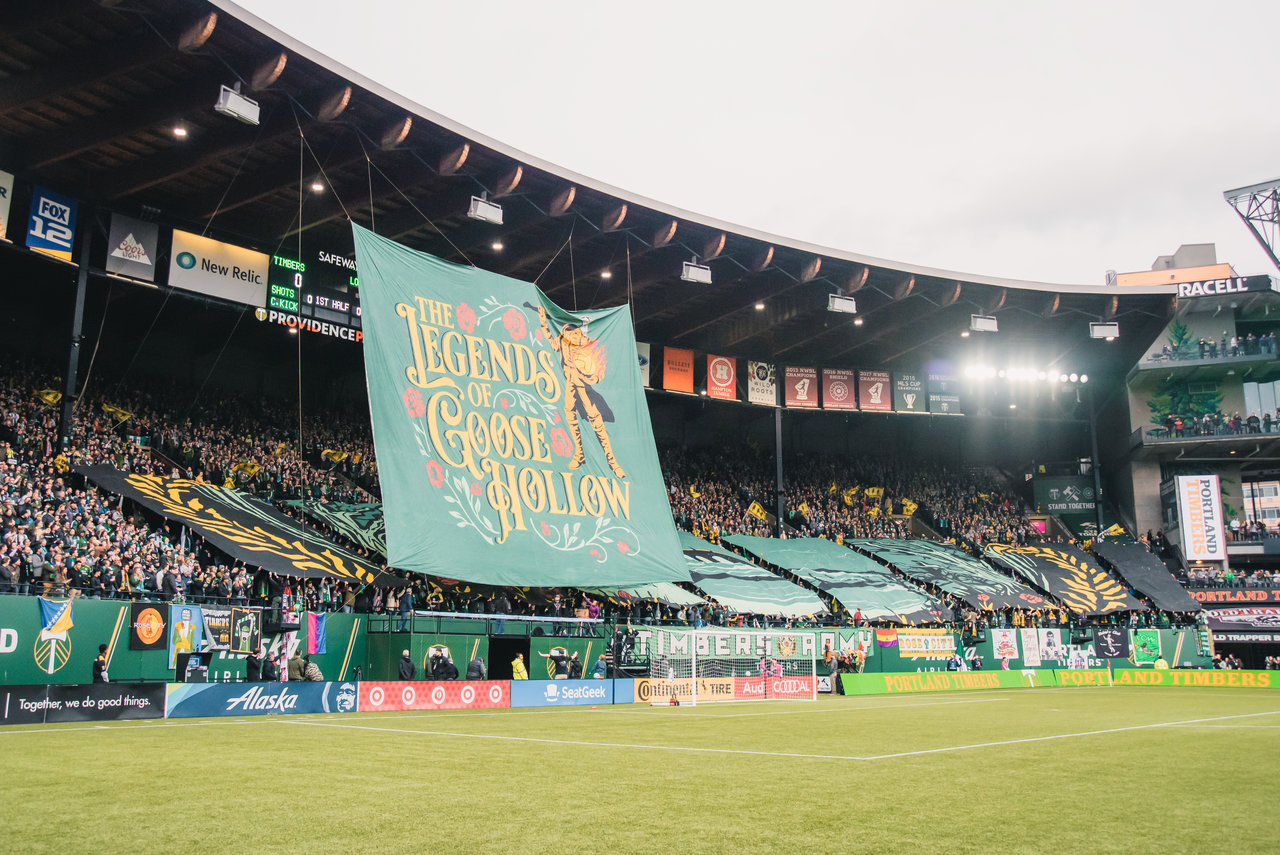
Pinnell: Going back to what you’ve seen out of the Timbers, when you watch them in Orlando, what will you have to see change to make it seem like the team is going in the right direction or that you’re seeing positive change?
Lowery: I think with the Timbers, seeing them shore up their defensive block would be big. Because I don’t think they’re ever going to be the team that has the ball for 60 percent of the game, or at least not in most games. When you’re not that team, your defensive block is really important because you’re playing against the ball for a lot of the game.
Going back to LAFC as an example, imagining a matchup between those two teams on the field, right now I don’t have a lot of confidence in the Timbers’ defensive shape to be able to contain a possessive team like that. But if they come in, they understand their roles in a defensive block—if they’re in a 4-4-2 or 4-5-1, whatever it is—they understand their assignments, where they need to be, and how they’re going to shift to deny penetration and force the ball wide if that’s what [head coach] Gio [Savarese] wants to do. They’re going to need to know when to trap, when not to trap, and when to step versus when not to step. If they can work that out, and if they have worked that out in this last three-month break, that’s going to be a great asset for them. That takes the Timbers from being a bad team in my mind to being a dangerous team that you don’t really want to play.
Pinnell: Looking at Diego Chará, he sometimes drops into the backline to help the team build possession and carry the ball into the midfield. How do you see the Timbers getting the ball from the backline, which you’ve said yourself doesn’t have any players excel at playing out of the back, into the midfield where they can be more dangerous?
Lowery: Having [Diego] Chará drop a little bit is a look that I actually really like with the Timbers. Maybe it’s Valeri, maybe it’s Blanco, maybe it’s Paredes dropping in a little bit; it allows the midfielders to get touches on the ball and distribute, which I appreciate. You just find the balance with that because you also want Valeri and Blanco higher up the field as well. Maybe you bring one of them down deeper into midfielder and you have the other one staying a little higher, that’s fine. I like that rotation with [Diego] Chará dropping from his six spot in between the center backs, moving the center backs out wide, pushing the full backs a little higher, and then you have Valeri and Blanco in those interior channels or in the middle of the field.
Then you have Yimmi Chará or whoever else is playing up front, that allows you to get those guys touches off of passes from Valeri and Blanco. Moving [Diego] Chará deeper I actually think is a pretty sustainable and successful look for the Timbers.
Pinnell: Now, when you observe the roster as a whole, who are some important players that you will be keeping an eye on?
Lowery: I want to see if/when/where Jeremy Ebobisse plays. I don’t think anybody really knows where he is going to play. I think that he should play as a [No.] 9 or as part of a front two, but that can be difficult with needing to give Valeri some touches up top, or how do you defend as part of a front line in a defensive block. I want to see where Ebobisse factors in, because I think he has something to bring to the table that he hasn’t had the chance to show for the Timbers.
Outside of that, I want to see more from Paredes as well in midfield. He’s a guy who is the unsung hero of that midfield in a lot of ways. [Diego] Chará gets a lot of headlines, and then Valeri and Blanco get the rest, so it’s a little challenging to know exactly what impact he’s going to have in this tournament. I like him as a player; I want to see more of him and focus on him more in that Timbers midfield. So Ebobisse and Paredes are the two guys for me that I am curious to watch with a more analytical eye on this tournament.
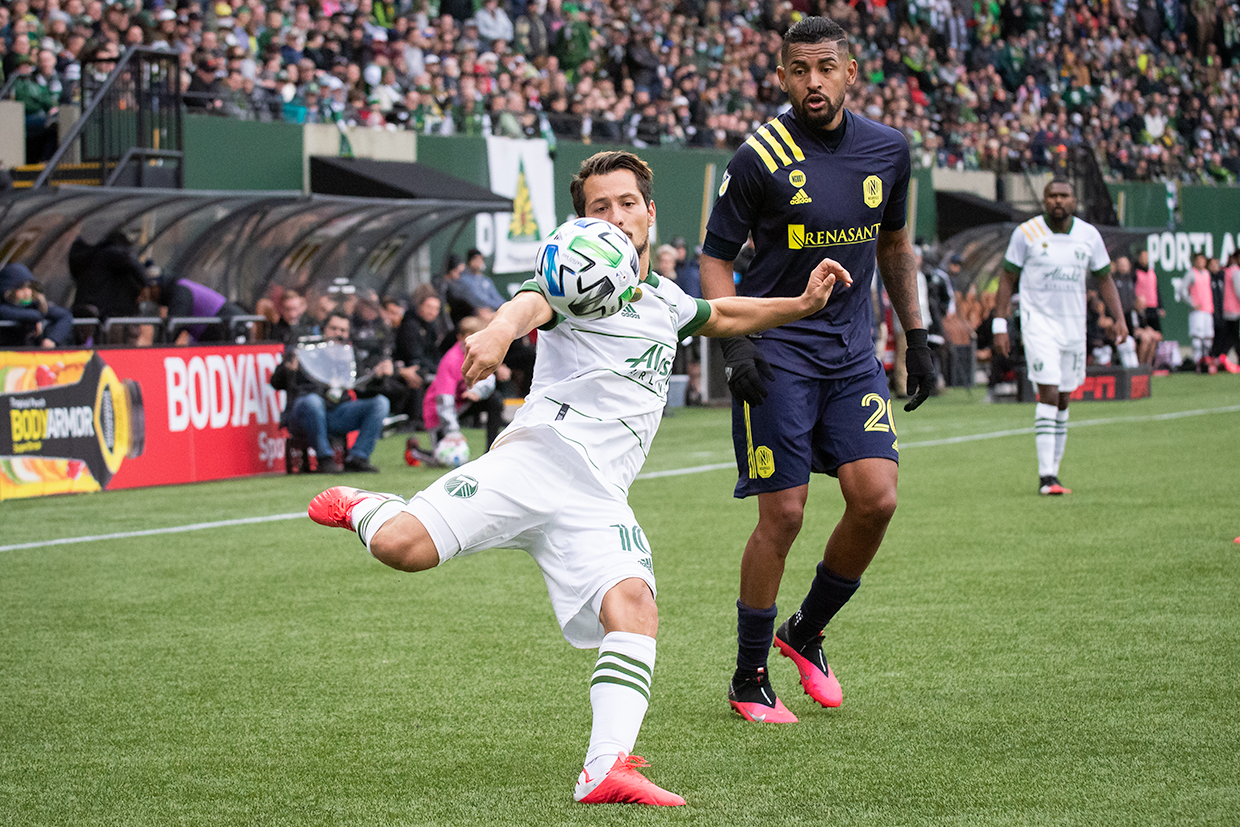
Pinnell: We started our conversation by talking about Group F as a whole, and honestly, the two teams that advance from the group could be a toss-up. With every team having questions, it might come down to which team has the most tactically adept coach who can tinker enough to find that formula to get them through the group. What coach do you think gives his team a distinct advantage for that second spot?
Lowery: So far, Barros Schelotto has been very predictable with how he plays, getting crosses into the box early and often throughout games. I think that unless we have a come-to-Jesus moment there with Barros Schelotto, then we’re going to see the same thing which is fairly predictable in a lot of ways.
Tab Ramos, I just straight up don’t know. Houston’s roster I don’t think is as talented as the Galaxy’s, maybe more similar to the Timbers in that regard. And with Gio Savarese, they’ve got the MLS Cup appearance, sure, but I’m not necessarily convinced that the Timbers are the finished product right now either. I’m not sure whether one coach has the tactical edge over another, to be quite honest with you.
Outside of Bob Bradley—I think he’s the number one guy in this group if we’re looking at just coaches. In terms of talent, though, if the Galaxy don’t advance from this group, and they actually try because we don’t know how the on-field quality is going to be, with Cristian Pavon especially—who I think is right up there with Carlos Vela in terms of best player in MLS, I think we’ll see that if we get a season this year—if they don’t make it out of this group, that’s going to be a little more unfortunate for them than it is for the Timbers or Dynamo. But as far as coaches go, I think it’s pretty even.
Pinnell: I agree, Bob Bradley definitely seems to be a level above most other coaches in this league. In an article that I recently published, I mentioned how the Timbers might be able to exploit space between lines. In a tournament like this, how do you think that the team could create that space?
Lowery: I think first of all that LAFC and Houston will open themselves up, which is good for a team like Portland because they want to attack into that open space. Looking at the Galaxy, that’s a different question. A lot of times they are going to get forward just because of the roster they have. They have the attacking talent, so it would be ridiculous for them not to get forward.
Still though, the Galaxy don’t play the same way that LAFC do or that Tab Ramos wants to do with Houston. So against a team like the Galaxy, they’re going to have to have possession a little bit more. They’re going to have to rely on their playmakers to get balls in from the backline or from Diego Chará, and then allow Diego Valeri’s off-ball movement, which is very very good, and have that captain them to better possession results. They have the tools in possession, and in the attack especially.
Getting the ball to Diego Valeri is one thing, but once they get the ball there, if they can get the ball there, then you are really cooking with something. If Valeri and Blanco can get on the ball in dangerous spots and get the ball to those spots in the first place, then the Timbers can pose a real threat with the ball against a team like LA. Creating and exploiting space in possession is going to be the thing for them, and I really do think that it comes down to how well their playmakers can get into spots and then distribute from there.
The rest of our conversation with Lowery is available in audio format for our $10 Patrons. You can find it under the “Patreon” tab on our website.

With the MLS is Back Tournament set to kick off less than a month from now in sunny Orlando, Florida, there are still questions to be answered about basically every aspect of the league’s return to play.
How will MLS cope with spiking COVID-19 cases in Florida as the country struggles to implement the proper measures necessary to fight the pandemic? Who will broadcast the games and make them available to soccer-starved fans? After a four-month layoff, will teams be able to put together anything approaching a coherent game of soccer?
But before all of that can be addressed, there is one question that looms above all others: how the hell are you supposed to abbreviate the “MLS is Back Tournament”?
Look, nobody calls it Major League Soccer; we all call it MLS. Nobody calls it the National Association for Stock Car Auto Racing; they call it NASCAR. Nobody calls it the NCAA Division I Men’s Basketball Tournament; they call it March Madness.
The abbreviation is the name, and the abbreviation for the MLS is Back Tournament is a freaking mess.
So, let’s explore our options.
***
***

***
(Experimental Prototype Soccer of Tomorrow)
Folks complain that I don’t tweet about Epcot anymore even though it’s been closed for weeks and the only thing happening there is skunk vine growing like crazy and taking over the whole place.
— Epcot Centre (@EpcotCentre) May 14, 2020
***
(MLS is the Second American Sports League Back Tournament)
How many times am I going to have to retweet this? C'mon folks. This isn't hard. https://t.co/1fomMGxOSl
— Anne M. Peterson (@AnnieMPeterson) June 19, 2020
***
***
***
@timbersarmy as long as the team keeps paying the termite control bill pic.twitter.com/TRNpgOjeRu
— Keith Palau⭐️ (@kpduck) October 22, 2014
***
Josef Martinez is just openly trolling Orlando at this point. #ATLUTD #ORLvATL pic.twitter.com/I1XjSEPPUn
— MLS Buzz (@MLS_Buzz) August 7, 2019
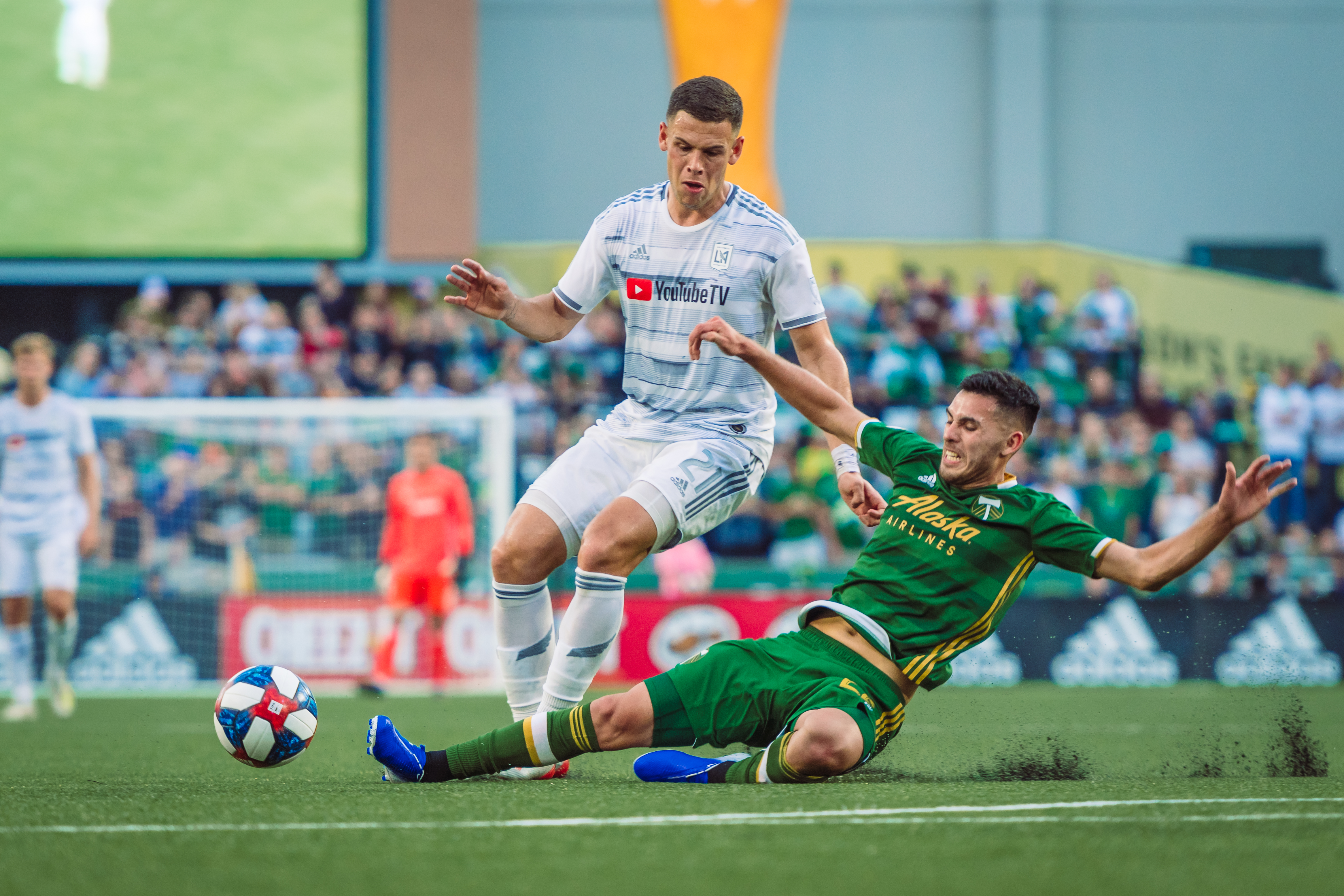
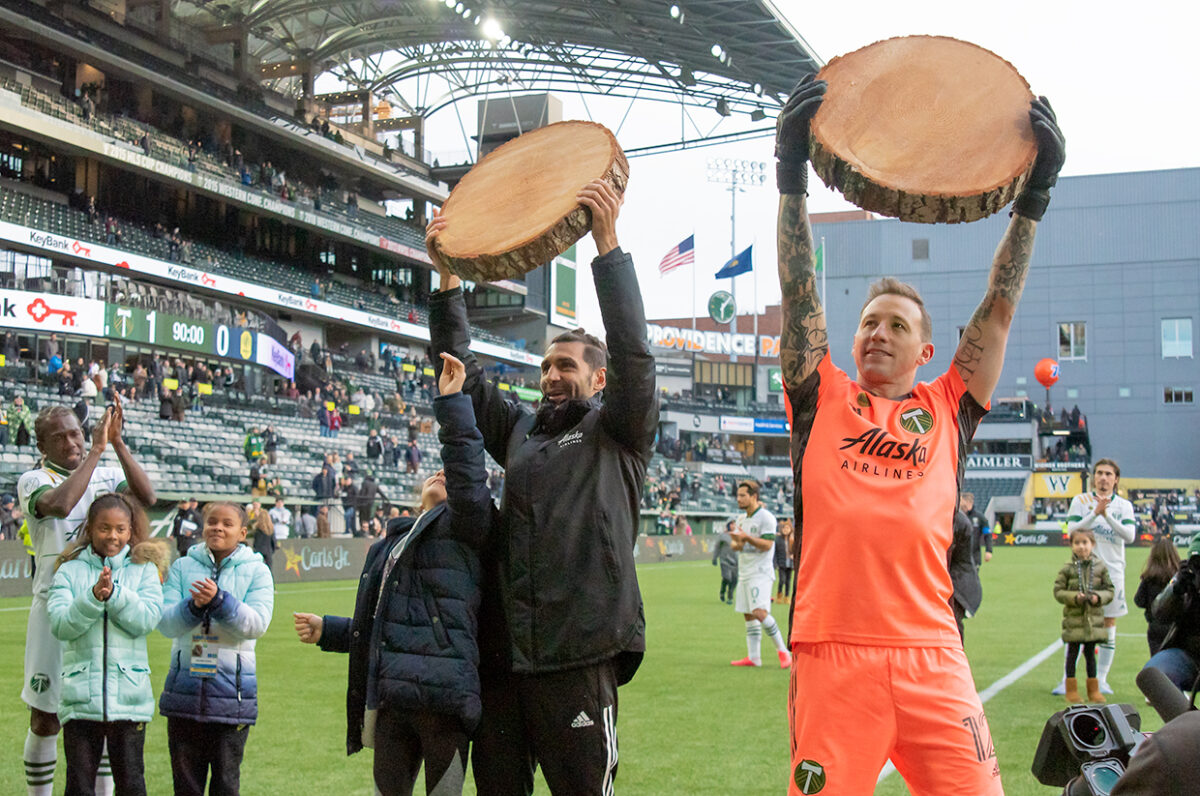
With just over 12 minutes gone in the Portland Timbers second game of the 2020 MLS season, Diego Valeri took a step back, turned, and struck a bouncing ball past Nashville SC goalkeeper, Joe Willis, on a half-volley. 1-0 Timbers. Unbeknownst to anyone at the time, that individual moment of brilliance would be the last Timbers goal for over three months.
In just over a month, the Timbers will take the field once again, but this time there will be no green and gold smoke or victory log slices. In fact, it will not be anywhere close to the Pacific Northwest.
Instead, the Timbers and other teams from around North America will be leaving their home markets to converge in Orlando, Florida for a tournament that would never have happened in a pre-COVID world. What will that tournament look like with no fans in the stands, no supporters groups, and no tifos? Well, nobody knows for sure.
It wasn’t long ago that many people within the league believed returning to play soccer in the first place would be impossible. Now, optimism is growing as additional information about COVID-19 becomes known. After nearly three months of archived games, streamed FIFA competitions, and too many organizational Mount Rushmores to count, the league is beginning to plan its path forward.
Despite many recent positive developments, it has not always been smooth sailing. Just a few days ago things looked choppy when multiple reports surfaced that the Players Association and the league were still at an impasse, held up by details like the language of a new force majeure clause and shared media revenue.
These talks came to a head over the weekend when ESPN’s Hérculez Gómez reported that the league threatened a lockout if the two sides couldn’t reach a deal in the coming days. On Wednesday morning, MLS commissioner Don Garber spoke to national media via Zoom about the labor agreement and said that this has been one of the few times in the history of the league that a severe measure, such as a lockout, has been considered.
“As leader of this league, I believe that [threatening a lockout] was important to do to reach an agreement,” Garber said. “At the end of the day, if we didn’t believe we were advocating for what was crucial for the success and the future of the league, I certainly wouldn’t have gone down that path.”
In addition to outside reporting, Garber admitted that there were four to five points that the two sides had to agree on, citing both the force majeure clause and shared media revenue as points of emphasis.
From the players’ perspective, Portland Timbers goalkeeper Steve Clark said that many players knew that lockout threats were a part of difficult labor negotiations—although he fully expected that both sides would finally reach an agreement.
“Negotiations are always tense,” Clark told local media via Zoom. “Overall, you have two sides that wanted to play soccer. We both had competing ideas and we wanted to take care of our own, but again, working with the Timbers, Merritt, and Gavin is fantastic.
“Not only that, but all the owners were on several Zoom calls with players. Getting on with Don Garber on Zoom with hundreds of players and a few owners is really unique.”
What Clark said impressed him even more was the amount of involvement from every player on the roster. Whereas in the past just a few players per team would work on the negotiations, this year everyone—from the lowest player on the roster to the designated players—was heavily involved.
“I truly believe that players are the most united we have ever been, and there is a kind of historic enrollment from the top of the roster to the bottom,” Clark said. “And the other part of that is the willingness of the owners to hear us out and get out of their shoes to walk a mile in our shoes. I’m really grateful for that.”
Over the past few weeks, MLS training facilities across the country have been opening up for individual workouts. These openings are reliant on local regulations as well as testing capacity in local markets and sanitizing regulations enforced at the training facility. On Thursday, the league lifted the training moratorium, allowing teams to plan their return to full team training. If teams can return to full training in their local markets, they can delay going to Orlando for at least a week.
Clark, for one, is excited to get back on the field, regardless of where the game is played and despite the lack of fans.
“I’m a soccer player,” the 34-year-old said. “I play goalkeeper. That’s what I do, I think it’s essential to my being, and I’m really excited to be out there playing.”
During the conference call, Garber did not announce any set dates or times for the Orlando tournament but said that more details are on the way. And regardless of what the tournament brings in, the league will take at least a $1 billion revenue hit. So while limiting the tournament to a maximum of 35 days helps players such as Clark, who will be leaving his family for at least a month, it doesn’t help the league’s bottom line.
And when teams eventually kick off in Orlando, there is at least one glaring question that needs to be answered: what will the on-field product be like? This tournament will undoubtedly give the league nation-wide attention from those interested to see how it handles the moment. Those new eyes will almost assuredly turn away if the product on the field is subpar, even if teams are now essentially in preseason form. (It’s worth acknowledging that the first few games will not be representative of the quality of the league during a normal season.) It will take time for teams to reach the quality of a derby game, or even what MLS fans saw during their last glimpse of live MLS Soccer—an end-to-end 3-3 game between the Philadelphia Union and LAFC.
Despite those worries, Clark said that the team is revving to play and believes that the quality on the field will not suffer, despite the lack of energy from the stands.
“The product will be good on that field,” Clark said. “We’re going to want to win and there’s going to be ways that I’m going to communicate better without fans. People will be able to hear me. I’m looking at it not in a negative way, but in a glass-half-full to see how I can impact the game, or as a goalkeeper, with my communication, because everyone can hear me.”
While the return to play is a positive step for all parties, there are still the unavoidable losses. Among these are the loss of revenue, and the (temporary) loss of fans. Playing a Cascadia Derby without the Timbers Army or Emerald City Supporters in a stadium over 3,000 miles away won’t be the same. Yes, the tournament-winning team will get a million dollars and a trophy at the “Most Magical Place on Earth,” but for the league’s 25th anniversary season, it’s a bit of a disappointment.
There remain plenty of questions around the league, many of which have no answer, but with tough negotiations behind them and a tournament on the horizon, it’s up to the players and the league to make the most of the situation. If there’s one thing for sure, it’s that the players are ready.
“It was nice to have a break,” Clark began, “but it’s time.”
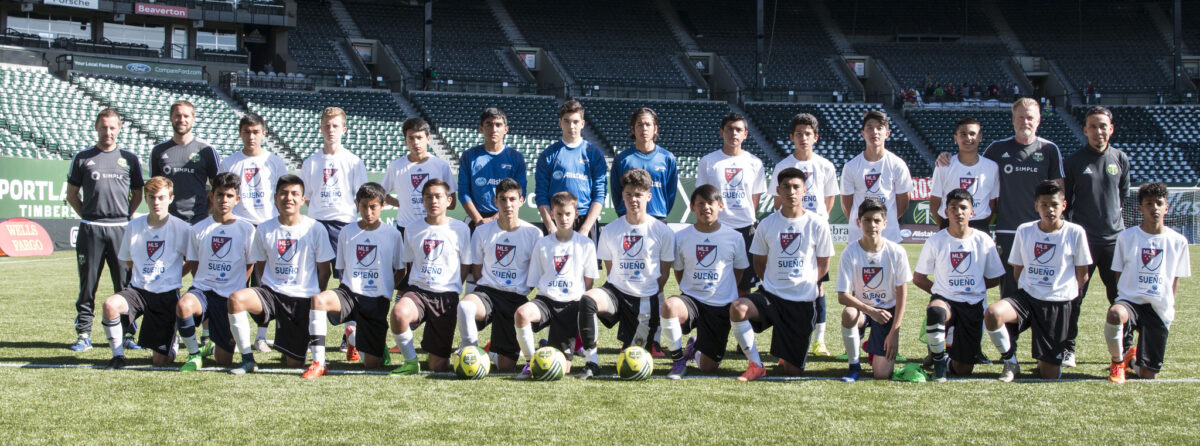
When Major League Soccer kicked off in the spring of 1996, one of its trademark features was its uniqueness.
In Europe, every league from England to Belarus is steeped in decades, even centuries of tradition. Meanwhile, MLS came into existence as an afterthought in a country with its own distinct sporting culture. To succeed, the league needed to find a way to stand out.
Run-up penalty shootouts; flashy, un-soccer-y team names like the Wizards and the Crew; and an actual playoff competition to crown a league champion. You name it, MLS tried it. So in 2007, when the concept of a reality-television-style competition to find the best young players in the country was pitched to the league, it was naturally given the green light.
That initial concept became Sueño MLS, a competition that lasted exactly a decade with varying degrees of success. The winner of that inaugural 2007 season was Jorge Flores, a young defender from Anaheim, California, who earned a spot in the Chivas USA academy. Today, Flores—nicknamed Sueño after winning the competition—goes by another surname: Villafaña.
In 2016, the competition named Portland, Oregon as one of its three first-round “host” cities for the first and only time. Up to 400 young players were allowed to participate, and six players (five field players and a goalkeeper) were then selected to travel to Los Angeles, California to take part in drill work and compete in scrimmages against local academies during a four-day finals.
Yet, despite its billing as a big-time competition, many of Portland’s finalists learned about Sueño MLS through happenstance. Andres Labate, a 15-year-old from Salem, heard about the event through his Argentinian father who heard an ad for the competition over the radio. 16-year-old Jonathan Reynoso, who lived in Madras, said that he heard about the competition through a friend at the very last minute.
On Sunday, April 16, hundreds of young players from around the region spent a beautiful, sunny afternoon at a Gresham public park in front of experienced evaluators, including Larry Sunderland—then the Portland Timbers Academy and Youth Technical Director, who took part in the competition twice when he worked for Chicago Fire—and Ryan Miller, an academy coach.
According to multiple players, the field in Gresham wasn’t ideal. Faded green with chunks of grass out of place, players claimed that it was difficult to dribble and play precise passes. But even the field couldn’t take away from what Miller called a “soccer-rich environment.” He said what really stood out while watching the scrimmages all day was the excitement among the players and an atmosphere that involved plenty of families hanging around for hours and even picnicking at the park. Labate claimed that the day felt like a scrappy and competitive club tryout, while Reynoso recalls being split into different teams and playing with a lot of different players.
After the first tryout wrapped up, participants were told to expect a phone call later that night, if they advanced. While some players could tell by their performance whether or not they would be invited back, Sunderland and Miller left Reynoso sweating until the last minute.
“I was on my way home and I was thinking that I wasn’t going to go back the next day,” Reynoso said. “It was already eight p.m., nine p.m., but then I got the call.”
Those who received a call that night were invited to Providence Park, where evaluators further trimmed the field to just six finalists, who would represent Portland at the finals in LA. Once again, the tryout consisted mainly of scrimmages—and even involved Timbers forward Dairon Asprilla, who showed up to support the young players.
“There was a lot of pressure,” Reynoso said. “All those people there and it being in an actual stadium. It was fun though.”
Many talented players tried out that week, but there was one clear standout, and everyone knew it: Alan Gaytan. The 15-year-old from Troutdale was athletic, had a great left foot, and quickly impressed evaluators and television crew alike.
“It was pretty clear that of the kids that were there, he stood out,” Sunderland said. “He was dangerous, he could run the ball pretty well, he was good in the one-vs-one. At that Sueño level and that tryout level, he stood out to us.”
Gaytan, who ended up winning the entire competition a few weeks later, excelled at cutting in from the right and curling his shot into the corner of the net. “It was an easy pick,” Sunderland said.
The rest of the selections were not as straightforward. To come up with the other five finalists, evaluators had to scrutinize seemingly minute details.
“It comes down to moments,” Sunderland explained. “It’s easy to find the very top and identify the bottom third. It’s that grey area between the top grouping and the middle grouping. It’s catching the right moments, seeing the right thing, being able to identify potential versus performance. Unfortunately, when you do a tryout like [Sueño MLS], a lot of time you are looking for performance because you do not have enough time to judge potential.”
Added Miller: “Alan was a clear standout in the event because he was an athletic player, he was fast, he was left-footed, he was playing with joy. There weren’t too many questions about him.”
Shortly following the conclusion of the final scrimmage, players were called to the field where Sunderland and Miller officially announced the six finalists. Gaytan, Reynoso, and Labate were called up, along with midfielder Arturo González Vásquez, goalkeeper Antonio Campos, and defender Salvador Pérez. With excited family members in the surrounding stands, many participants called this their favorite moment of the weekend.
“I thought I played well, but I got really tired at the end,” Labate said. “My dad was there and we discussed it. I went down there, and I knew Alan [Gaytan] was going to get picked, but I was not sure about anyone else. It felt amazing to be selected.”
“If I were the director of Sueño, the atmosphere is what I would put my hat on,” Miller said. “That culture and environment that was created, I thought that was really cool.”
When asked about the final selection, Reynoso chuckled. He knew that he would be selected before the official announcement due to being accidentally tipped off on his way back from a water break. The forward admittedly didn’t know what he was seeing at the time other than his name on a computer screen, but he got a good idea as soon as the woman using the laptop quickly shut the screen.
“Once the game finished, I don’t know why, I was just behind everyone,” Reynoso said. “I was looking at the computer and they had the names written down already. So I saw my name on there way before [everyone else].”
Over the course of a decade, 11 separate players have gone on to win the competition. However, not every winner has gone on to find mainstream success in soccer. In 2015, Villafaña went on to win an MLS Cup in Portland and has earned a few international caps for the United States. Gabriel Funes Mori won the competition in 2008 and has since played the role of prolific striker for River Plate, Benfica, and Monterrey. Other winners are still in college, local academies, or are not playing soccer anymore.
“At that time I didn’t see [winning the competition] as pressure, I saw it as an opportunity, which I think is different,” Villafaña admitted. “I imagine every kid’s dream is to be a professional soccer player, and when I won I didn’t see it as pressure, I saw it as an opportunity to be a professional soccer player. That is what my drive was to keep me going. That I had this opportunity that I always wanted.”
Many other players echoed a similar sentiment of how Sueño MLS, as niche a competition as it was, influenced their soccer paths.
Labate, who is committed to playing soccer at Gonzaga University next year, knows that the competition helped him get noticed by the division-one school in the first place.
“Oh, for sure,” Labate said when asked to reflect on the competition’s impact. “Academy level compared to club is a step up, as well as, the connection to college coaches is better. The amount of people who I have gotten into contact with and the connections that I have made were all through the academy and the fact that I played there.”
In an interview back in 2016, Villafaña told MLS.com that “If it wasn’t for the Sueño MLS, I probably would’ve gone to college and I don’t know what would’ve happened. But I’m sure I wasn’t going to be playing professionally.”
Today, Sueño MLS no longer exists. After ten competitions, 2016 was the final run of a soccer reality-television show. And, in its final iteration, the competition gave the country a taste of just what talent can come out of the Pacific Northwest.
“It’s tough because [winning the competition] doesn’t mean that you made it,” Villafaña said when asked about the primary lesson he took away from a competition that helped kick-start his career. “It means that you’re just starting. It’s like every other guy that wants to become a first-team player.
“Once you are in the academy, it doesn’t mean that you have made it. It means that you have an opportunity to become a professional soccer player, so you have to see it as an opportunity, because there are a lot of kids that want to be there, and not a lot of them have the opportunity.”
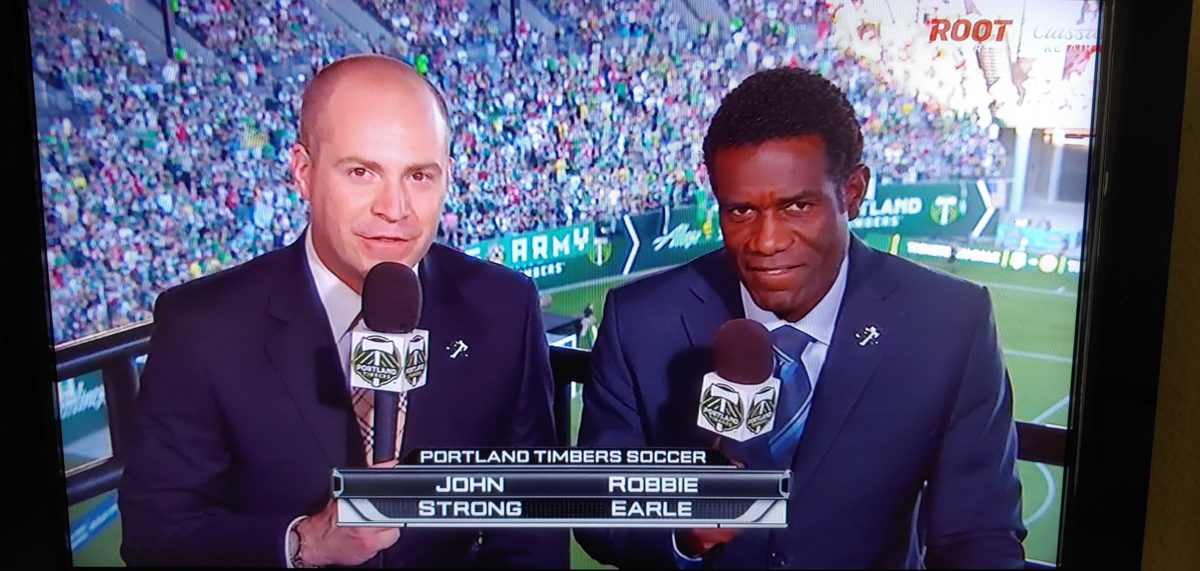
Look through the names of past and present Portland Timbers broadcasters, and you’ll find a who’s who of American soccer media. Jake Zivin’s voice can be heard both locally on ROOT Sports and nationally on Fox Sports. Nat Borchers and Ross Smith both have their own place in Timbers history, on and off the field. Preceding them, John Strong is now the play-by-play voice of North American soccer on Fox Sports, while Robbie Earle is a staple of English Premier League studio coverage on NBC Sports. The common thread between them? They all got their start in American soccer broadcasting by covering the Portland Timbers.
A few weeks ago, Strong tweeted a picture of his television screen. On the screen were both him and Earle on the catwalk at Providence Park, filming a pregame segment. Nearly a decade younger, both men wore black suits with Stand Together pins on their left lapels. At that point in time, few could have predicted the highs to which their careers were about to ascend.
From 2011 to 2013, Strong and Earle were the voices of the Timbers, forging a unique relationship and chemistry early on. At the time, it was considered an odd pairing. Around MLS, the English personality was typically the play-by-play voice, while the American filled in as color analyst. Portland flipped the script.
“It was really the first time anyone had done that,” Strong said.
Before coming to Portland, Earle had a playing career in England, playing midfield for both Port Vale and Wimbledon. After hanging up his cleats, he spent ten years covering soccer in England until around 2010, when he decided to try his hand in America. One of the first people to reach out was Timbers President of Business Mike Golub, who sold him on the city and vision of a franchise that was about to enter Major League Soccer.
“It was immediately obvious to the team that as an option for our broadcast, this guy would bring instant credibility to our announcer team,” the Timbers’ vice president of broadcasting, Matt Smith, said.
And while the organization had to go across the pond to find Earle, Strong was right in their backyard. A talented yet inexperienced 25-year old radio broadcaster out of the University of Oregon, Strong covered some of the team’s final USL games and was chosen to continue broadcasting games in MLS.
The two leaned on one another during those years. If Strong needed to talk to the TV truck, Earle was prepared to cover for him. Earle, meanwhile, learned about American media, as well as how to always be prepared, from Strong.
“His unending patience with me,” Strong began. “The amount of battles that he fought for me that I didn’t realize at the time. Things I was just too young and stupid to realize that I was saying on the air that I didn’t need to be. I was way, way too young to have that job really, and the way Robbie acted as a firewall sometimes, with people that were annoyed with things that I have done or said that I didn’t know until years later—it was very appreciated.”
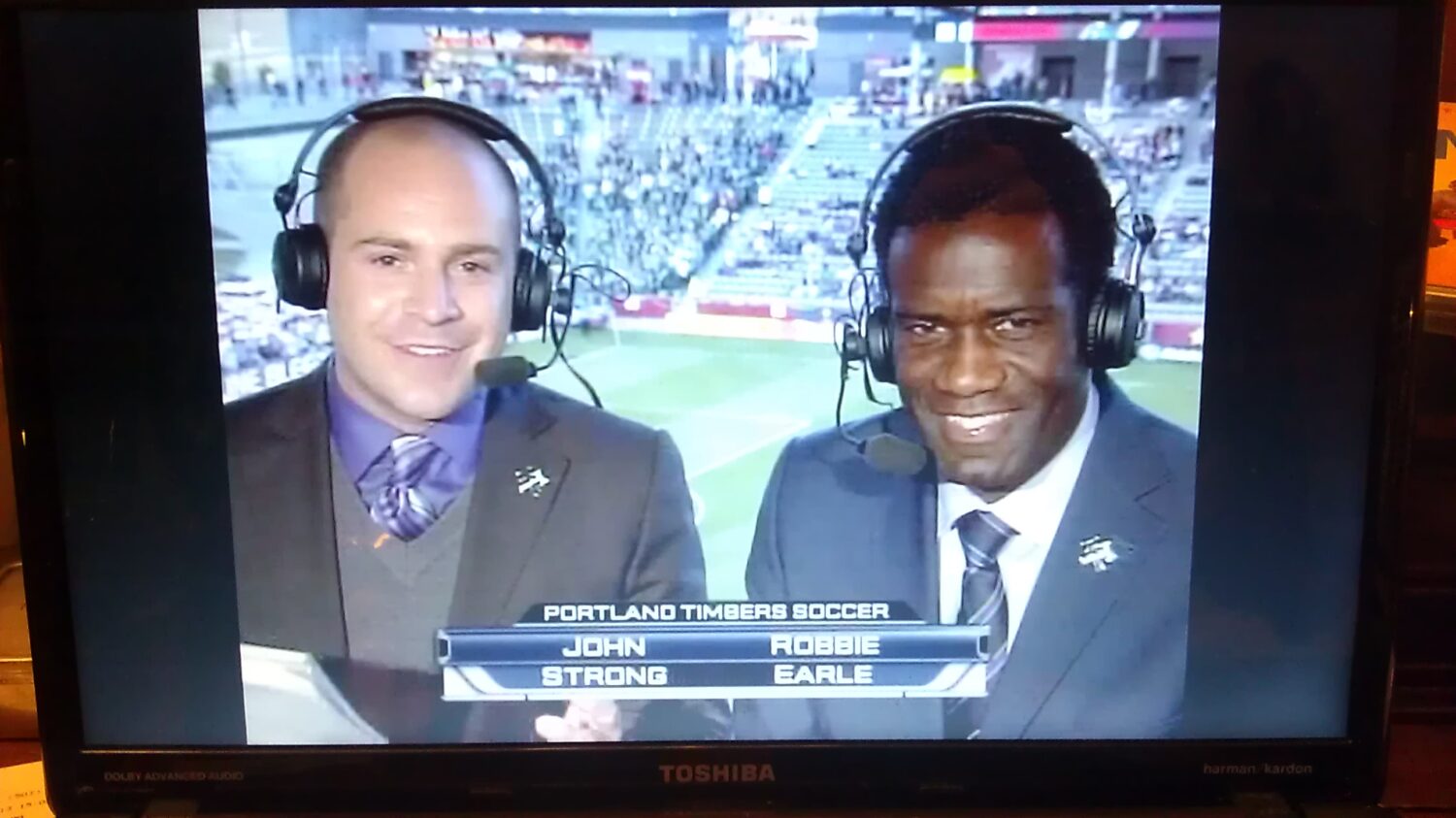
Alongside Earle, Strong had another helping hand in longtime friend Erick Olson. Growing up, Strong and Olson had helped found the broadcasting program at Lake Oswego High, then spent their college years calling UO games together. In 2011, Strong asked Olson to help keep stats and spot from the booth. Olson knew his friend’s weaknesses and echoed how valuable Earle was during the early days of Strong’s career.
“We got the chance to start with not a whole lot of safety net, just a whole lot of trust,” Olson said. “It wasn’t like we were getting a ton of feedback, unless we sought it out, through college. So having Robbie come in and help us with those things was very beneficial.”
Strong still recalls a lot from his time with the Timbers. Over the phone, he named some of the early players from that 2011 team with painstaking detail, even recalling the health situation among the three goalkeepers at the time. Strong is a storyteller, and 2011 provided him with plenty of stories to tell.
There was the Timbers’ first home game against Chicago where, as the rain poured down, he couldn’t help but watch Earle, who looked stunned while absorbing the moment. The team won its first five home games—a feat no other expansion team before them had accomplished—blew out the eventual shield- and MLS Cup-winning Los Angeles Galaxy, and put an end to Real Salt Lake’s 18-game unbeaten streak.
In July, Strong spent the moments right before the Timbers and Sounders met in MLS for the first time watching the US Women’s National Team beat Brazil in the World Cup quarterfinal. That was his first time meeting Alexi Lalas, who came into the radio booth that day to watch the ending. Unfortunately for Timbers supporters, the game that followed didn’t have the same happy conclusion.
“There was such incredible energy in the building that day,” Strong said. “The Timbers led twice, but ultimately gave up a late equalizer on an Ozzie Alonso penalty. It was absolutely soul-crushing. That was one of the biggest gut-punch losses for the Timbers, really maybe even ever, because to lose in that way was rough.”
Over two years in Portland, Strong was never at a loss for words. But behind the scenes, there was one moment that came close: the team’s first-ever MLS game.
“I remember our first game against the Colorado Rapids where we talked about what opener we wanted, we didn’t want to get in the way of the club,” Earle said. “I remember the kick-off and turning to John to shake hands, which we did before every game for good luck, and he had tears streaming down his face. I didn’t realize how much the Portland Timbers meant to him as someone coming from the area, going to the lower leagues, working in football.
“In that first game in MLS, how emotionally it caught him. He had these Portland Timbers cufflinks on his shirt. It caught me off guard and made me say, ‘wow.’ If these are the emotions of a broadcaster who does very professional work, I was thinking about fans at home and the responsibility we had.”
It was those passionate fans that blew Earle away as soon as he arrived in Portland. He still believes that he and Strong had the best gig in MLS at the time, and still fondly cherishes the memories of passing fans lined up at the gates of Providence Park hours before every home game.
Growing up in England, and with experience playing in some of the most hostile environments in Europe, Earle compared Portland fans to some of the most passionate supporters in England.
“Not in terms of numbers, but in terms of love of the football club, [Portland] would probably be more like Newcastle United or Leeds United,” Earle said. “Two very strong identity clubs. When you go to those areas, you never see people in those cities wearing any other shirts. If you come from Leeds, you support Leeds. If you come from Newcastle, you wear black and white. I always think the Timbers are like that. The only soccer shirt you see people wearing with pride would be the Portland Timbers.”
According to Smith, when Earle was with the team, road dinners were full of stories that nobody on the TV crew could get enough of—stories of his time playing for a Wimbledon team nicknamed the “Crazy Gang,” and of playing for Jamaica. It was that paternal nature that helped Earle build great relationships among the entire broadcast crew, but particularly with Strong.
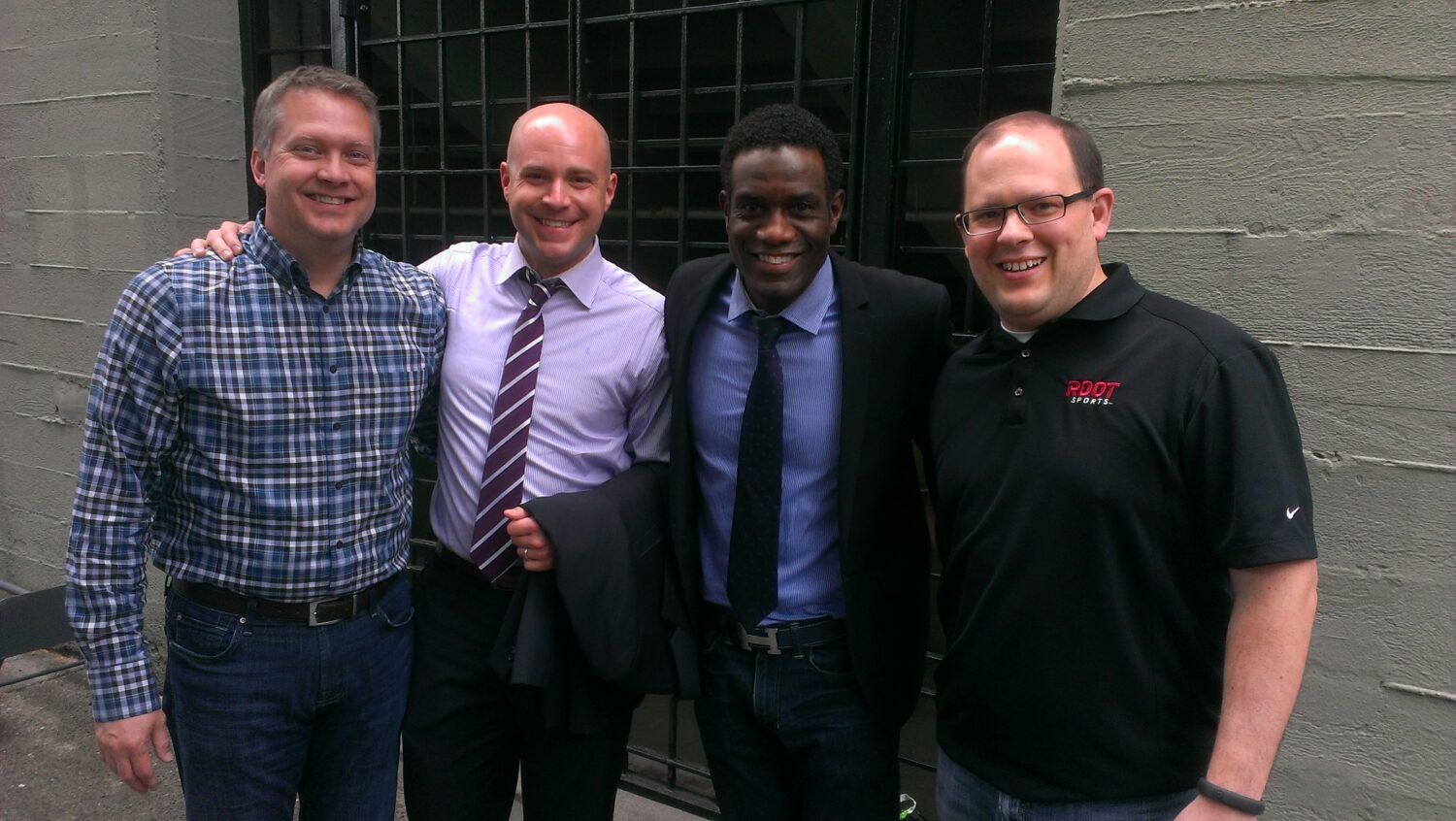
If there was a single moment that cemented the pair’s relationship, it came on October 2 in Vancouver.
Back in September, Strong had suffered from a case of pneumonia that later resulted in a collapsed lung. Just ten days after surgery, he made the trip to call the team’s 1–0 victory over the Whitecaps, but he was not himself.
“He came back a week or ten days too early,” Earle said. “He traveled up to Vancouver and didn’t look great in all honesty. He was quite pale and looked as though he was still not 100%. But, being John, he wanted to be back because he felt it was his responsibility.
“Thinking back on it, the one thing John brings to a broadcast is energy. When he came back, he didn’t have that same energy, and a couple of times I caught him having to catch a breath and take a moment.”
Strong later admitted the same thing. Back in 2011, he acted in haste.
“I should not have called that game,” Strong emphatically said. “I had no business doing that game. I looked sickly, I lost a bunch of weight, it was a disaster. But I was so desperate. I had finally gotten this dream job, and now it’s like it was being taken away.
“I remember doing that game in Vancouver and Robbie almost like a dad. He got emotional, having me back, and he gave me a big hug. It was a really nice moment even though I shouldn’t have been there.”
Looking back, those days meant a lot to Strong and Earle, but also to Olson. Watching his friend develop his career right in front of his eyes, in their hometown, was a special experience. Olson later accompanied Strong to the World Cup in Russia, but still reflects on 2011, which he knows was just the start of a long journey.
“Seeing something grow and, at the same time, watching my friend, who I had been broadcasting with since we were seniors in high school, grow into this role was special,” Olson said. “To go from the guy who is working really hard to make connections, to the guy who drives convincing people to put the Timbers on the radio so that there is a radio home for this professional team, to the guy who becomes the first TV broadcaster for this team. How much that meant and how hard he worked to get that done while at the same time making a real connection with the team. It was incredible”
So, back to that picture from the 2011 broadcast.
“Could any of us have predicted at game one that two and a half years later John would be the national voice on a network?” Smith asked. “I don’t think any of us would have predicted that, but by the time 2013 rolled around I was able to look at John’s peers around Major League Soccer and immediately knew that he was in the upper echelon of MLS announcers.”
For nearly a decade, the Timbers MLS history has been marked by inconsistent play on the field, an MLS Cup, and even a little bit of magic. But, through it all, there has been a talented television crew to tell the story. And it all began with John Strong and Robbie Earle back in 2011.
“Lots of people forget that the team was really darn competitive in 2011, right up until the end of the season,” Smith said. “There was a great atmosphere in Portland, a new expansion team that was upping the ante in Major League Soccer. But they were also competitive, and the Timbers were competing to be in the playoffs in year one. 2011 was exciting on all fronts, every aspect of it, and I think we had a great broadcast, great announcers, and the product we put on air was second to none.”
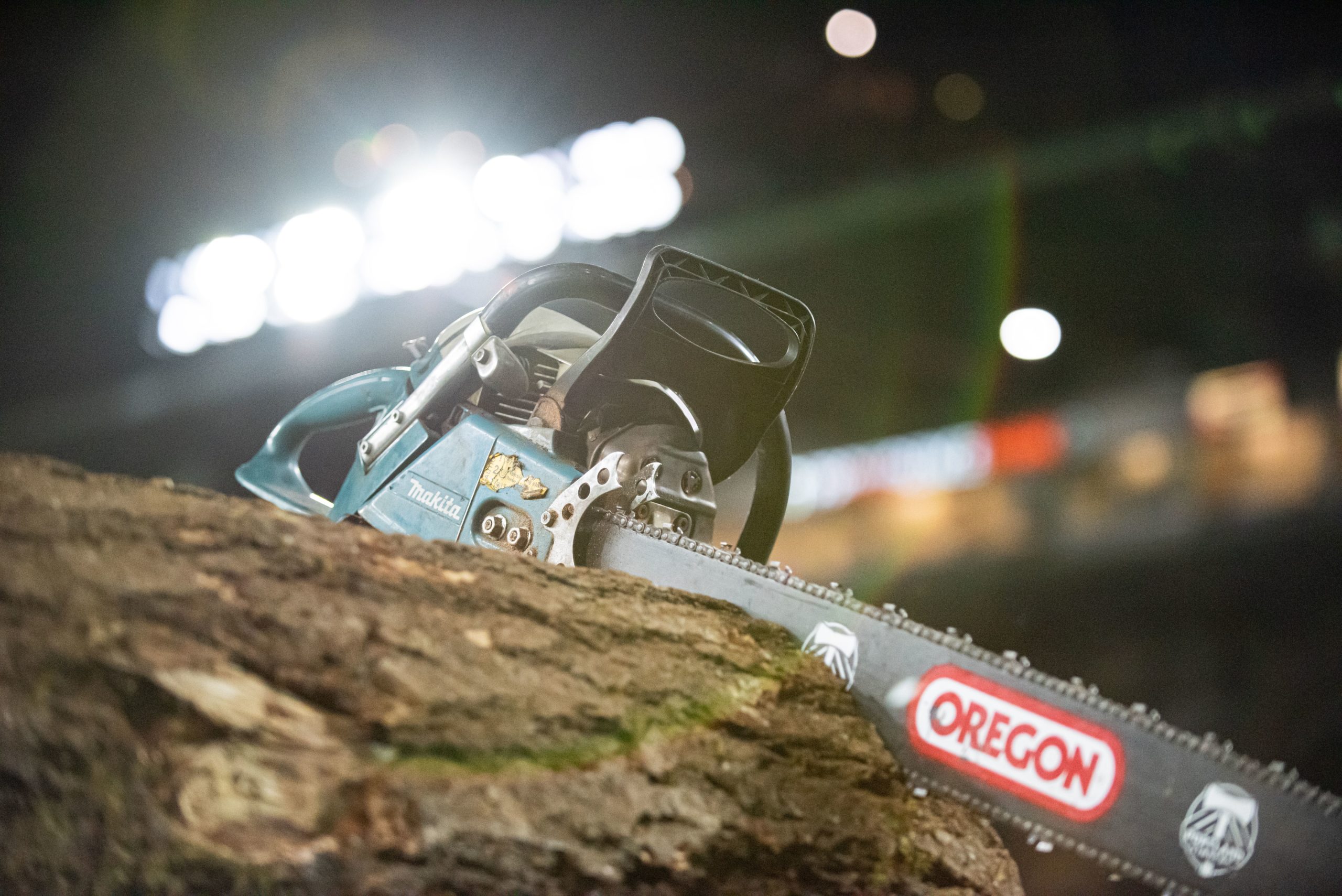
Former Portland Timbers play-by-play commentator John Strong landed at Seattle-Tacoma International Airport expecting to make a quick connection to a cross-country flight to Washington DC. But on his way to the gate, he received an unforeseen email from Timbers owner and CEO Merritt Paulson asking where he was.
Strong knew to assume inclement weather on the east coast during the coming weekend. According to multiple reports, Hurricane Irma was projected to hit the DC area, but Strong anticipated that the team, and Major League Soccer, would postpone that weekend’s game against DC United just a day or two, and that he could bunker down in a hotel in the mean time. That idea was dashed just a few minutes later when he received another frantic message, this time from the Timbers’ vice president of broadcasting, Matt Smith.
“I’m thinking they delayed the game and we’d play it Monday,” Strong said. “I was still prepared to fly to DC. But [Paulson] responds in all caps, ‘DO NOT GET ON THE PLANE,’ and within seconds Smith is calling me saying, ‘where are you right now?’”
Strong, of course, was on his way to the nation’s capital, but those plans quickly changed. 285 regular-season games have gone on without a hitch since then, until March 19, when COVID-19 shut the entire league down. That game, nearly a decade ago, stood as the only time a Timbers game had been postponed in its MLS era, and it resulted in one of the craziest and most memorable days behind the scenes in the franchise’s MLS history.

The team landed in Washington a day before the official postponement, arriving on Thursday night to an eerily empty Reagan Airport. It is team policy to arrive at road cities at least two days prior to an east coast game, so despite the rumblings about a potential hurricane, players and staff boarded the 2,800-mile flight to DC.
But in seeing how empty the airport was, with those passengers who were there scrambling to get out of the city, reality set in. By the time the team left the airport, Portland’s then-director of game operations, Nick Mansueto, couldn’t help but begin to contemplate a nightmare scenario—one that came to fruition 24 hours later.
“It was certainly a surreal feeling being at an airport, grabbing your bags, and being the only ones because everybody else in the airport is trying to leave,” Mansueto said. “It was strange to be the only group of people walking to the baggage claim, which made it all the more real and it hit home what exactly we were flying into.”
On Friday morning, just a day before the game was scheduled to be played, Mansueto recalls going outside to see weird cloud formations and feeling the wind pick up. Soon after, the call from the league came through: there would be no game that weekend, and the team would have to get out of DC. Players who boarded the bus expecting to head to training that morning were instead thrust into a crazy 24-hour experience that perfectly reflected the MLS 2.0 era.
One player who remembers that day well is former team captain Jack Jewsbury. He recalls the shock of switching mindsets from anticipating practice to having to turn around and fly right back across the country. As captain, Jewsbury left with the first group of players and would get to fly back out of Reagan.
“Nick [Mansueto] and his staff did as good as they could to get everyone on [flights], but you gotta think that everybody else in that area is trying to get out of there, too,” Jewsbury said. “It was a bit chaotic.”
Behind the scenes, Mansueto called it one of the most stressful and memorable experiences from his time with the team, one that involved booking an entire soccer team on cross-country flights in an ever-changing situation. The team was used to traveling in a controlled environment with tickets already printed, bags checked in, and expedited security lines. At that moment, Mansueto was just trying to get as many seats as he could together, and that meant securing two or three seats each on any planes departing out of Baltimore, Reagan, and Dulles airports—all at least an hour apart from one another without traffic—which meant lengthy layovers in four different cities.
“For me, it was important to get the guys out of there as quickly as possible,” Mansueto said. “If there were layovers, which there were, that was certainly a better situation than being stuck for an unknown amount of time in a city that you do not live in.”
By the time Jewsbury and the first group of players arrived at Reagan, they decided to enjoy a quick drink before the long journey home; after all, there would not be another game for a while.
“It was an odd feeling,” Jewsbury said. “You’re in your Timbers gear, you’re supposed to go to a game the next day, and you’re already coming back flying across the country. We had a few beers to settle the nerves a little bit because we had finally made it to the airport.”
Luckily, Jewsbury and the entire team arrived back in Portland in the coming days, but it’s easy to look back at that game and ask, “what if?”
In a way, it hurt the team to not play the game as scheduled. Back in May, DC United had become the first team to beat Portland at what was then Jeld-Wen Field, winning 3–2 in dramatic fashion. But by late August, the Timbers had caught lightning in a bottle, taking all six points from the Vancouver Whitecaps and Chivas USA in the span of four days.
Instead, the game was rescheduled for late October and became a do-or-die match for both teams. A Timbers win would have essentially guaranteed a spot in the playoffs if they could win or draw against Salt Lake City the following weekend. DC, meanwhile, needed all three points to stave off instant elimination. The game—which still holds an MLS record for most shots in a half of any MLS game since 2000—ultimately finished 1–1, with Kenny Cooper opening the scoring in the 24th minute, and Dwayne De Rosario scoring the equalizer in the 73rd. The Timbers were then forced to rely on another result; that game didn’t go their way, and the team was out before Decision Day.
“This is my hot take about 2011,” Strong said. “I think the Timbers win that game [if it had been played as originally scheduled] because they were playing with such confidence, and it was such a quick turnaround that they were running on adrenaline. By the time they played DC again at the end of the season, the team was out of gas.”
Jewsbury acknowledged Strong’s point, but he didn’t believe that one postponed game in August made that much of a difference in the team’s playoff fate that year. He did, however, agree that road points were hard to come by, and those three would have been extremely valuable.
“For me to say, ‘Hey, if we win that game, we are going to make the playoffs,’ is probably unfair, but we were in a groove,” Jewsbury admitted. “For a young team like we were, confidence was king. And we had that going at different times during the year, so to not get that one in hurt for sure, and you never know. We may have been able to grab that playoff spot, and you never know what is going to happen from there.”
That postponed game now stands as arguably one of the craziest forgotten stories from that 2011 season. Was John Strong right? Could the Timbers have actually snuck into the playoffs that year? We’ll never know for sure, but it’s a memorable flashpoint in what was an exciting inaugural MLS season for the Portland Timbers.
“Had the Timbers had the three points from the DC win, they would’ve come into the RSL game knowing that with a win they would’ve gotten in, or a draw might’ve been enough, depending on the result,” Strong said. “That’s always been my revisionist hot take. If it were not for that hurricane, the Timbers are the third expansion team ever to make the playoffs.”
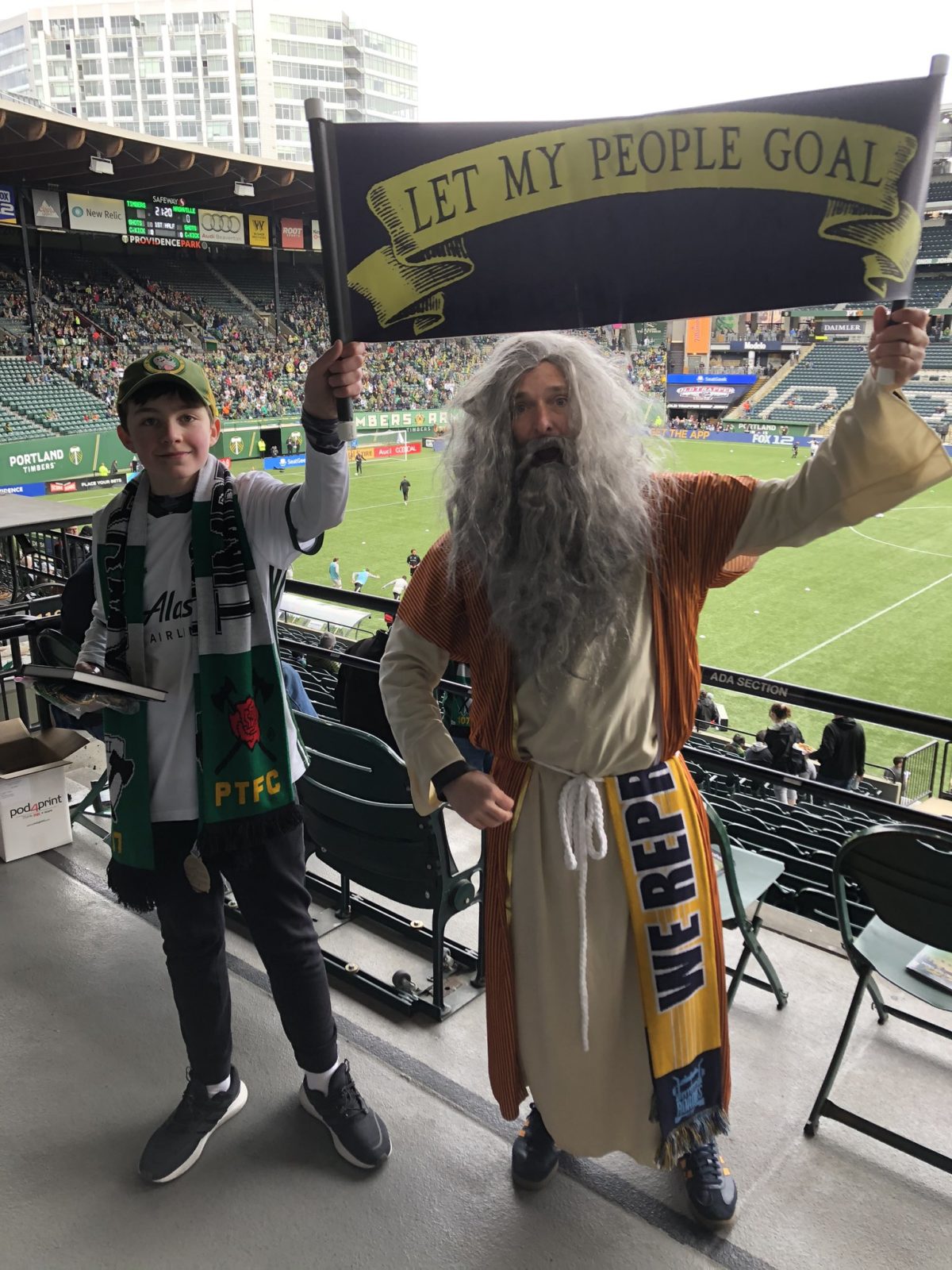
12-year old Anderson Mathews is like any other middle-school kid. He plays FIFA, enjoys collecting stickers and scarves, and secretly hopes that school will not return before his birthday. More than anything, he loves patches, soccer, and the Portland Timbers.
Mathews is a well-known member of the Timbers community, and his white Jeanderson jersey is often easy to spot in the stadium. Yet while his name may be Anderson, many fans know him by a different moniker: Ghost of Jeanderson, or GOJ for short. The nickname was given to him at a 2016 game in Seattle, when two members of the Soccer Touchdown Podcast mistook his name for Jeanderson, a former Timber who only played in three matches for the club. Both Mathews and Jeanderson were happy-go-lucky people, so the nickname ultimately stuck.
While Mathews may be young, he is a Timbers Army veteran. He attended his first Timbers game in 2012, when the team hosted Valencia in a friendly, a match he still has the scarf from. In 2016, he and his father traveled to the aforementioned Seattle game on the Timbers Army charter bus, where they made new friends and ultimately became dedicated fans. Now, his family is a staple among the thousands of supporters who fill the North End of Providence Park every home game.
It was a year after that first trip to Seattle that Mathews became intrigued by the patches that many Timbers Army supporters wore and collected. By 2017, that budding curiosity quickly became a hobby for both him and his family. After attending an away game at Cincinnati last season, Mathews came up with an idea. Collecting and trading patches was cool, but what if he could make some of his own?
When he returned home, he began to brainstorm an idea for his first away days patch.
“We lost terribly, but it was on St. Patrick’s day, so we made this patch that was Portland versus FC Cincinnati,” Mathews said. “It was in the shape of a shamrock, and it said PTFC versus FCC. We put a lot of detail into it. Last year I handed them out to all the people that went to Cincinnati.”
That patch became a hit, and sparked the idea to create a new and unique one for each time a new opponent plays the Portland Timbers. For the game against Nashville SC, Mathews and his family designed a patch in the shape of a guitar bearing the names of both teams, along with the phrase “Inaugural Game.” When the season resumes, the Timbers are scheduled to host Inter Miami. Right now, Mathews is thinking about shaping the patch like the Miami Vice logo with the words “PTFC versus Inter Miami,” but the concept is still being brainstormed.
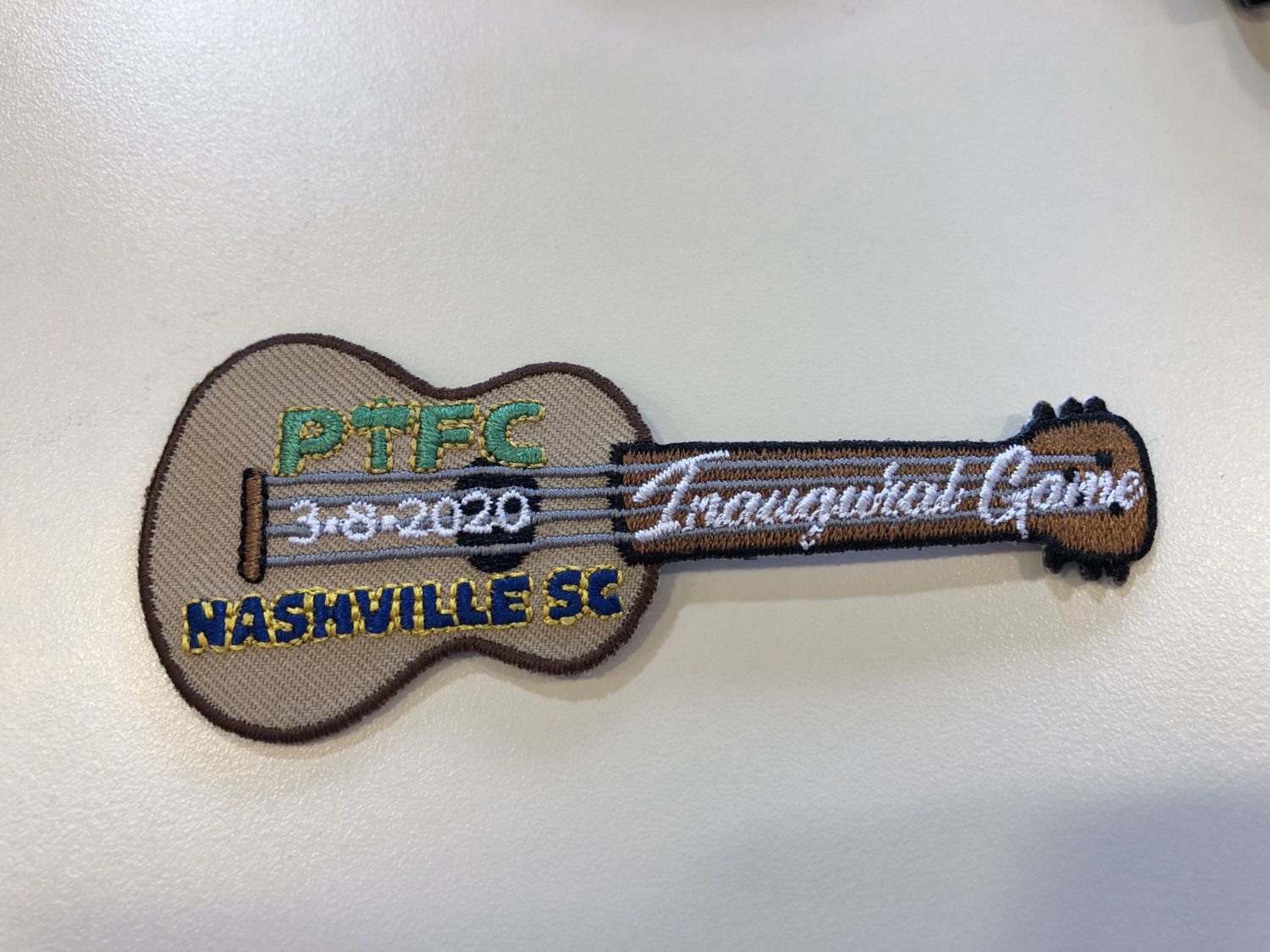
While these patches may sound simple, it takes months to see an idea through to its final stages.
The first step is coming up with an idea. Then, Matthews’ dad takes colored pencils and sketches out the design. From there, he and his family make small corrections before sending them into the factory that will produce the patches in bulk. The factory makes one copy of the patch and sends an image back to the Mathews family for approval before producing roughly 100 patches to ship to Oregon.
Last year, Mathews and his family created his favorite patch yet: an old-fashioned travel suitcase that sported mini pennants representing different MLS franchises. The patch was nominated for an award at last year’s Patch Palooza Pizza Party, an annual gathering for patch collectors and traders in the Portland community.
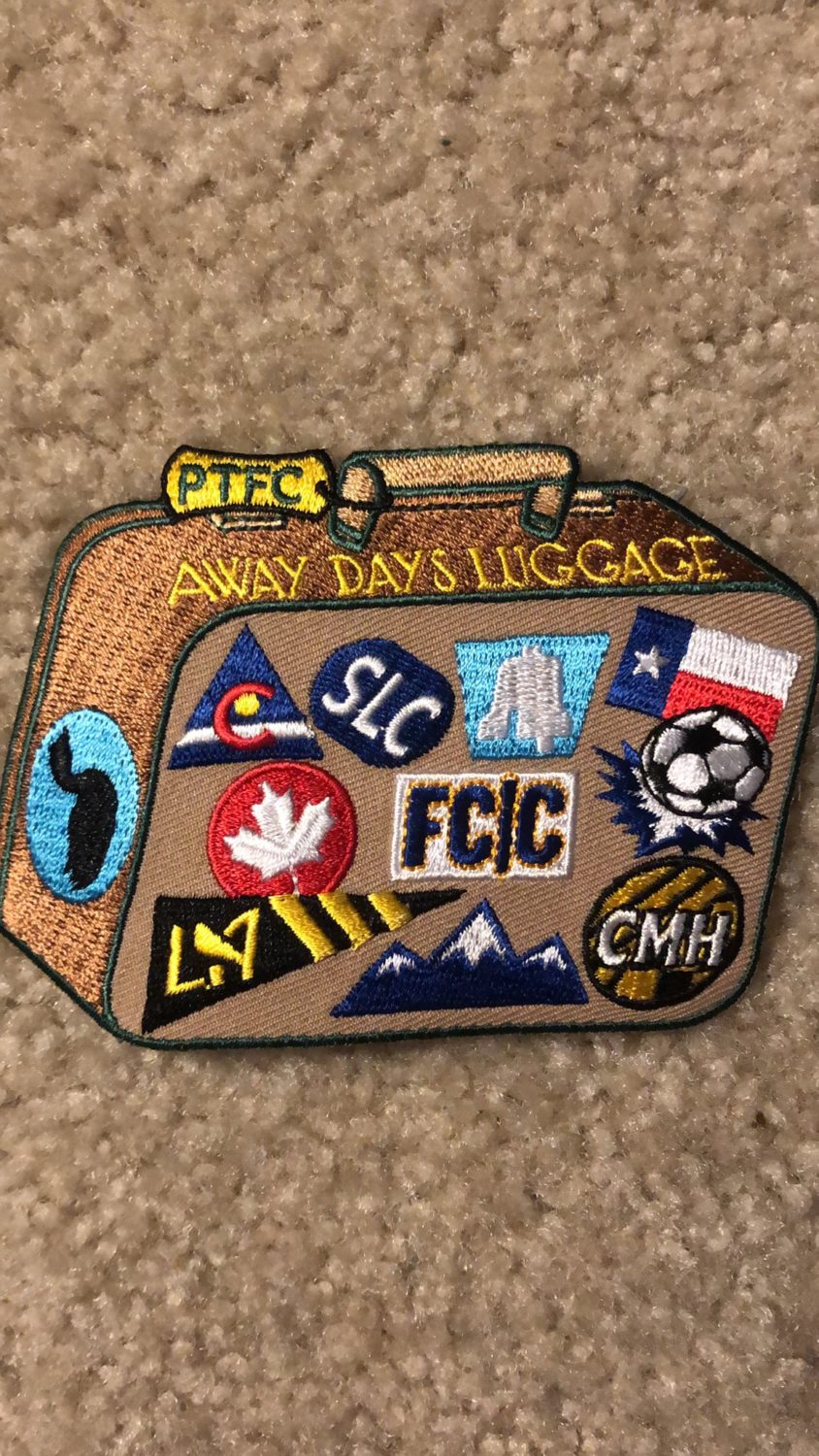
Oftentimes, these patches sell out quickly, but no single patch received more positive feedback than one designed as a pair of car keys that read “Go home you bums.” This patch, representing a Timbers Army tradition, sold out within 15 minutes. The family hurriedly placed a second order.
“People are nuts for patches,” Mathews said. “If a patch sells out in 15 minutes, people get mad at you.”
The thing about patches is that they are popular among fans and players alike. For example, if you take a close look at the right sleeve of Zarek Valentin’s jean jacket that he wore before a home game against Seattle last season, you may notice a small, circular patch depicting a ghost with a soccer ball. That is the “Ghost of Jeanderson Patch,” one that Mathews’ family created back in 2016.
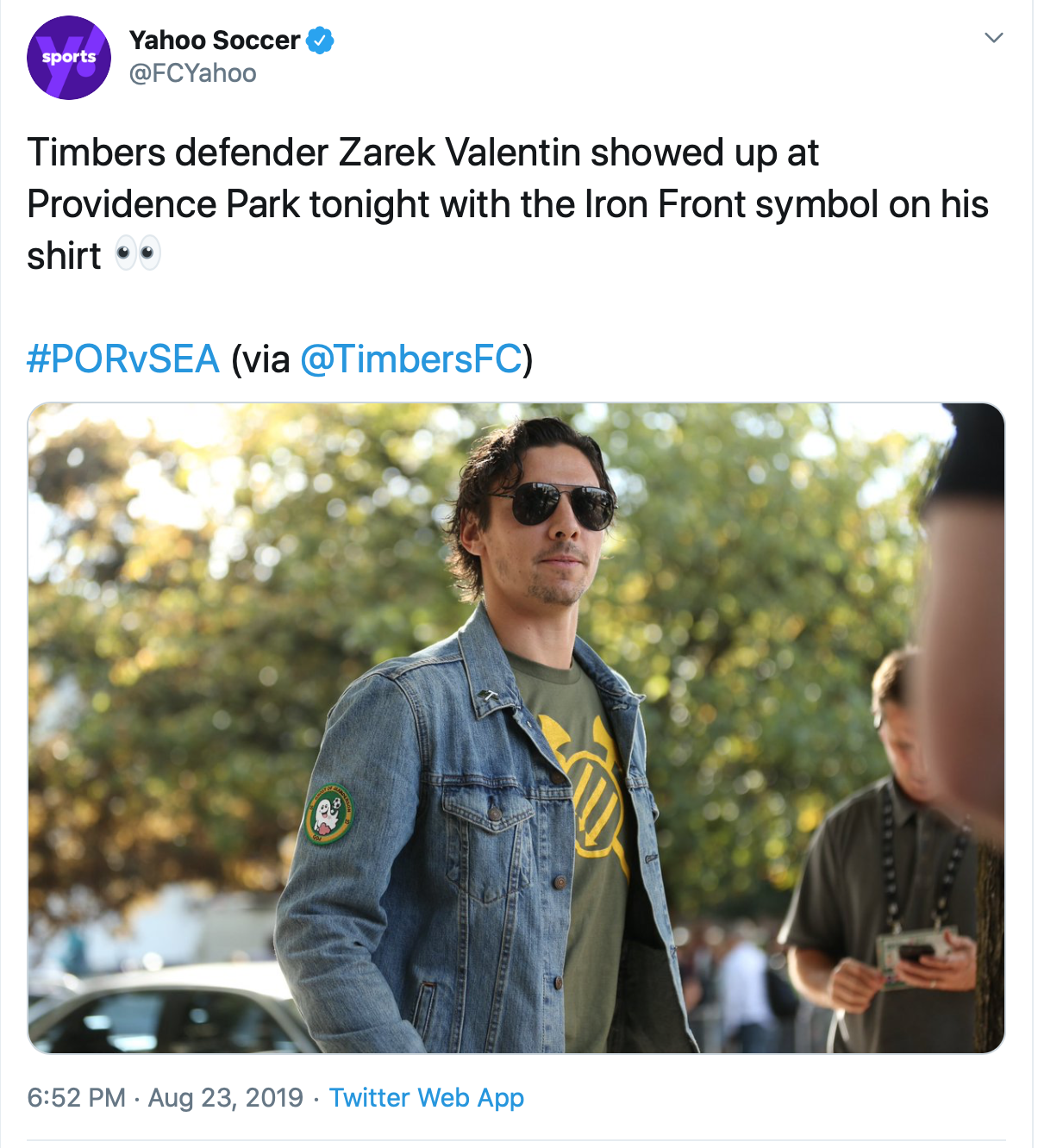
That particular picture was a surprise to Mathews, but he did know that Valentin was a fan of his patches. The two were first introduced to one another through the Soccer Touchdown Podcast. From there, they started to talk after games. In 2018, Mathews gifted Valentin his green jersey. Valentin kept that jersey with him, and during each game of the Timbers’ 2018 MLS Cup run he would send Mathews a picture of it.
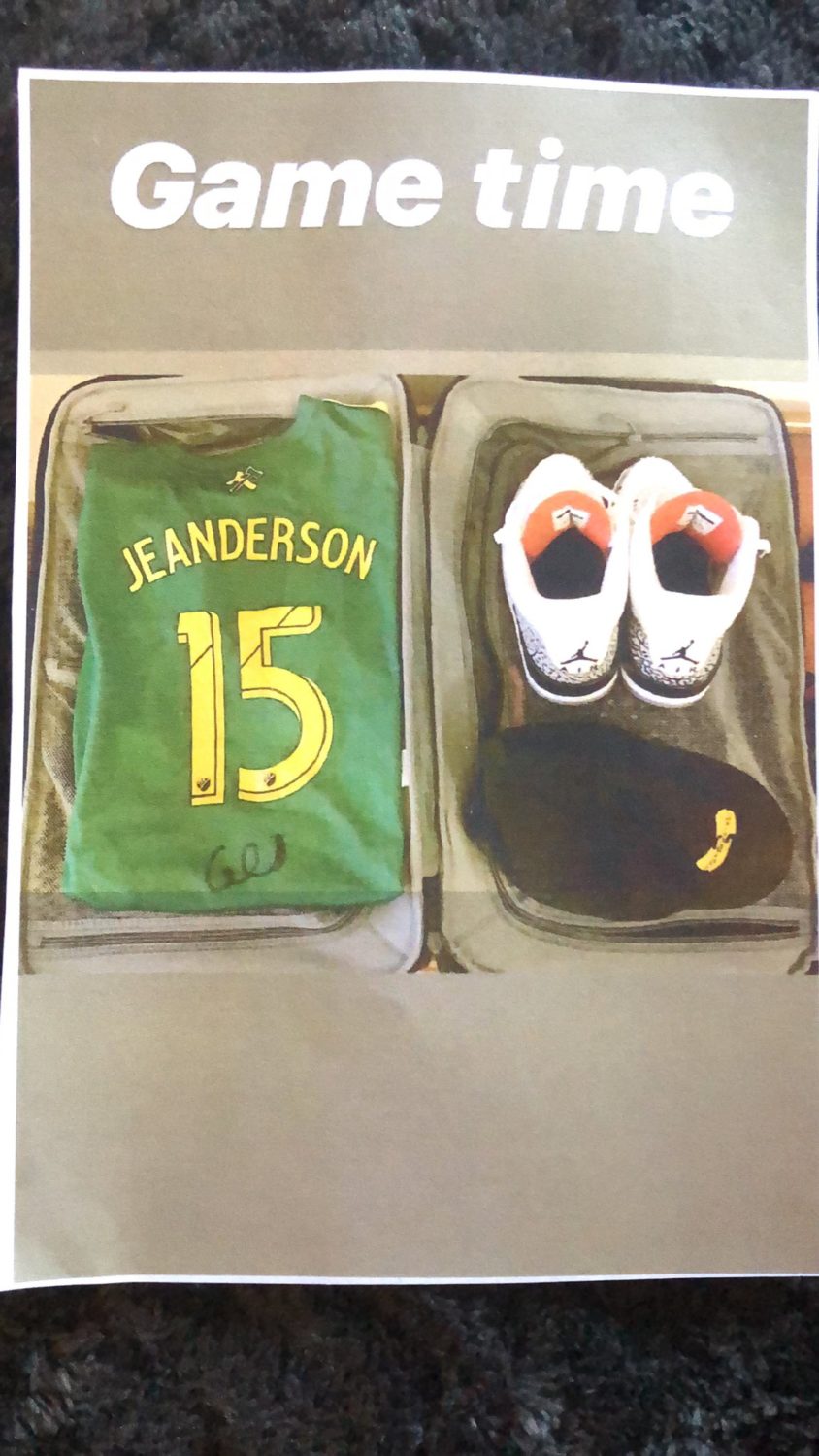
“When Zarek was a Timber, him and I hit it off,” Mathews said. “He would want to talk to me, and wanted to get some of the patches.
“Last year we made a mini patch jacket for his new baby which was a big hit,” Mathews added.
Over the years, Mathews and his family found success in creating these unique patches—even making some profits, which are ultimately redistributed.
“Any money left over from the patches we donate to charity, Mathews said. “Towards diabetes, cancer, just donating the money.”
When it comes time to finally deliver these patches at games, it is Mathews who makes the trip from section 102 to the top corner of 223 to personally deliver them. It allows him to meet new fans and potentially trade scarves. Even when there are no patches to deliver, he tries to carve out time to interact with visiting supporters before each home game. Well, most visiting supporters; there are some caveats.
“Here’s where I lay down the line,” Mathews started. “Seattle, I only go over to take pictures. Sometimes [I also don’t interact with] San Jose fans because they get a little too riled up.”
Those little moments of trading scarves and interacting with other soccer fans are what Mathews sorely misses right now. These days, most nights are spent anxiously thinking about and awaiting the return of MLS. When that happens, he will be ready to continue making and trading patches while supporting his favorite club. But, until then, Mathews will be at home doing what any other middle-school kid would be doing during this time of social distancing: playing FIFA, brainstorming new ideas for patches, and holding out hope that, for the first time, he won’t have to worry about school on his birthday.